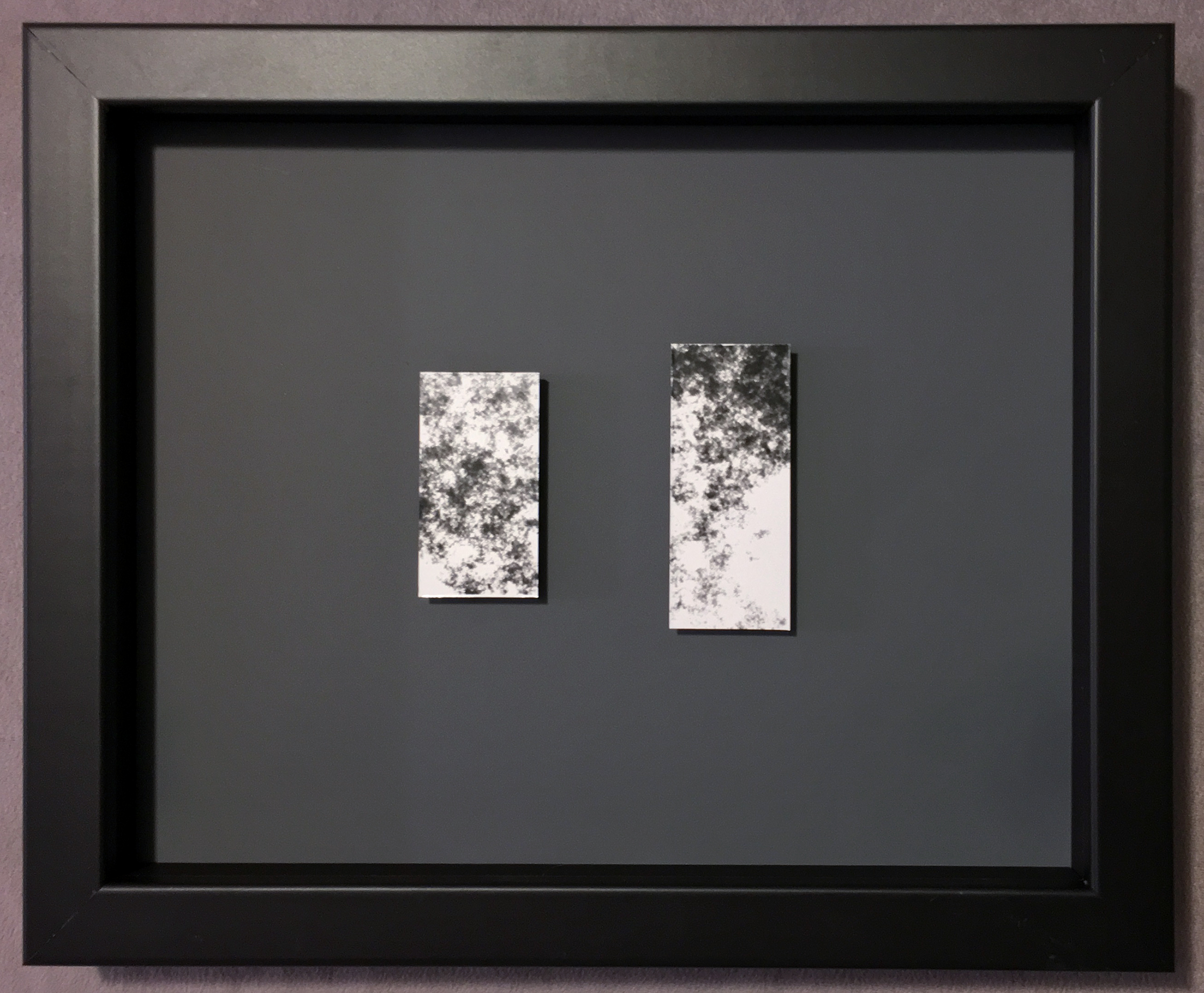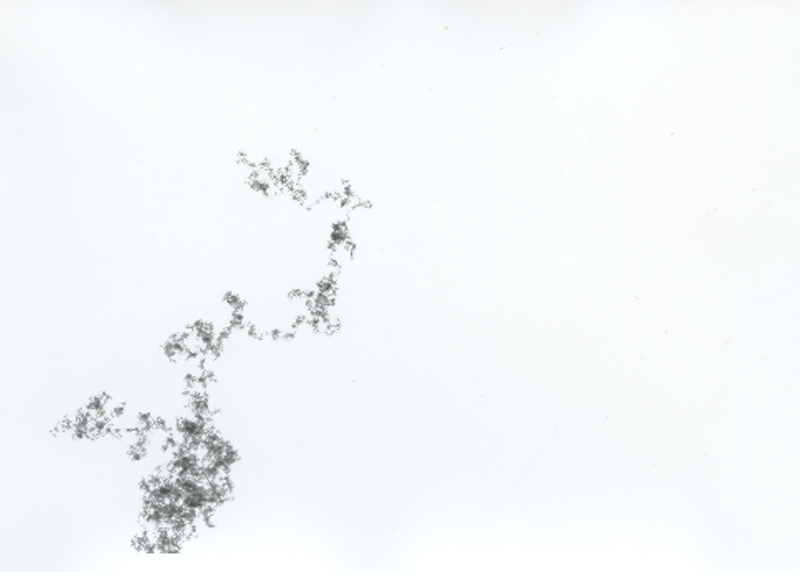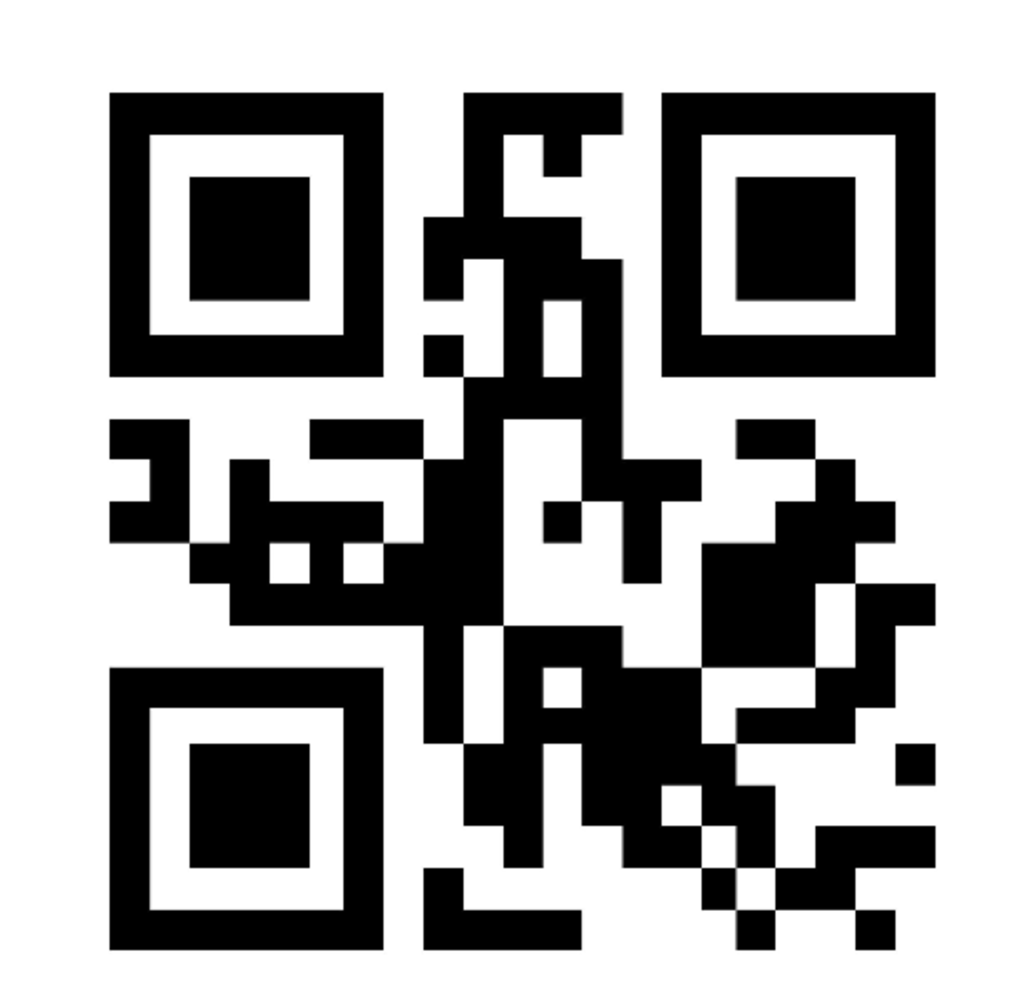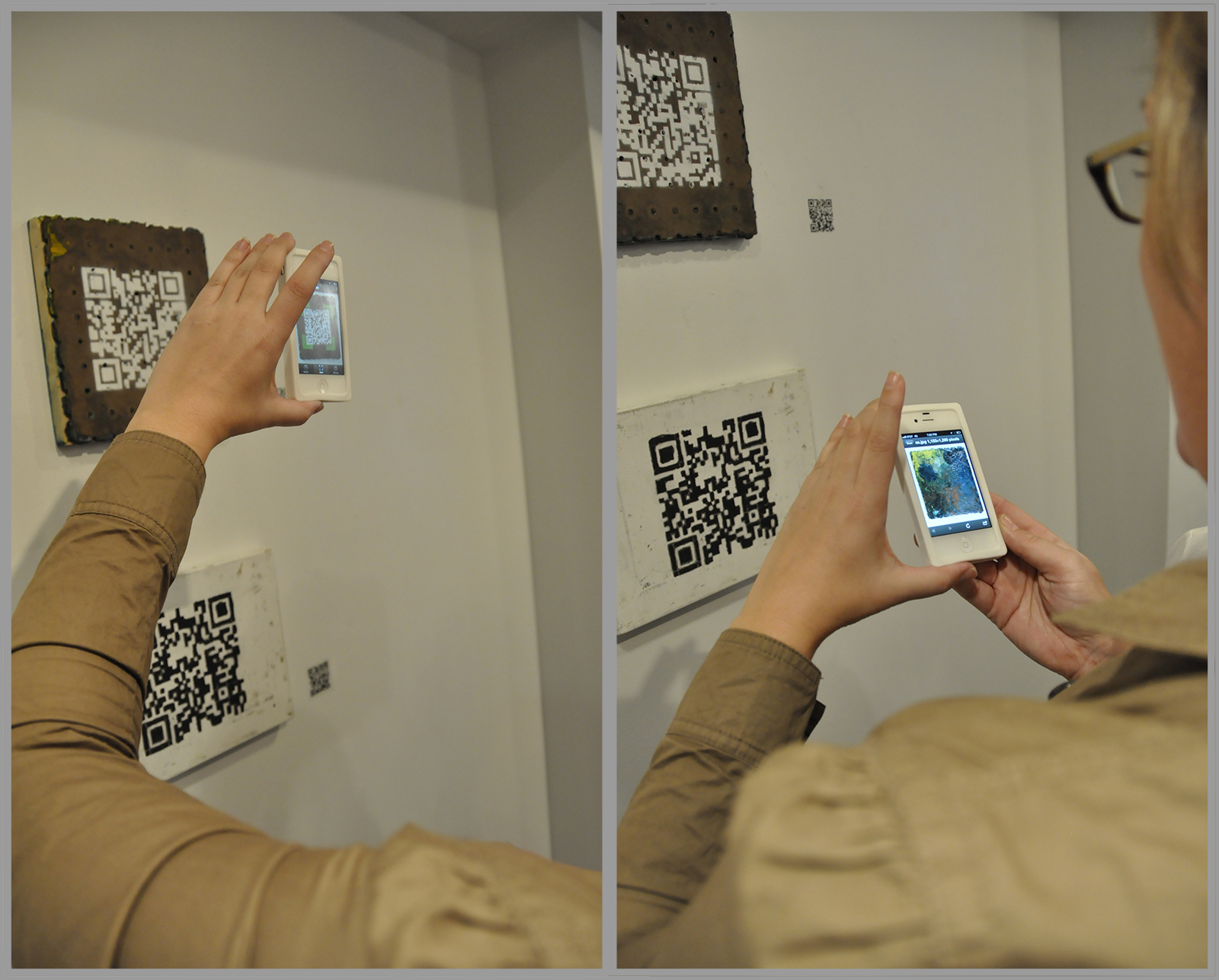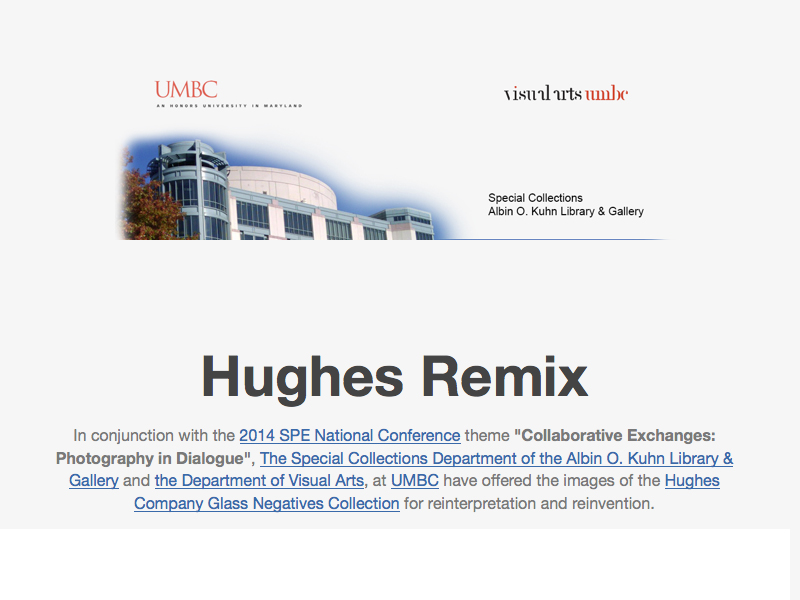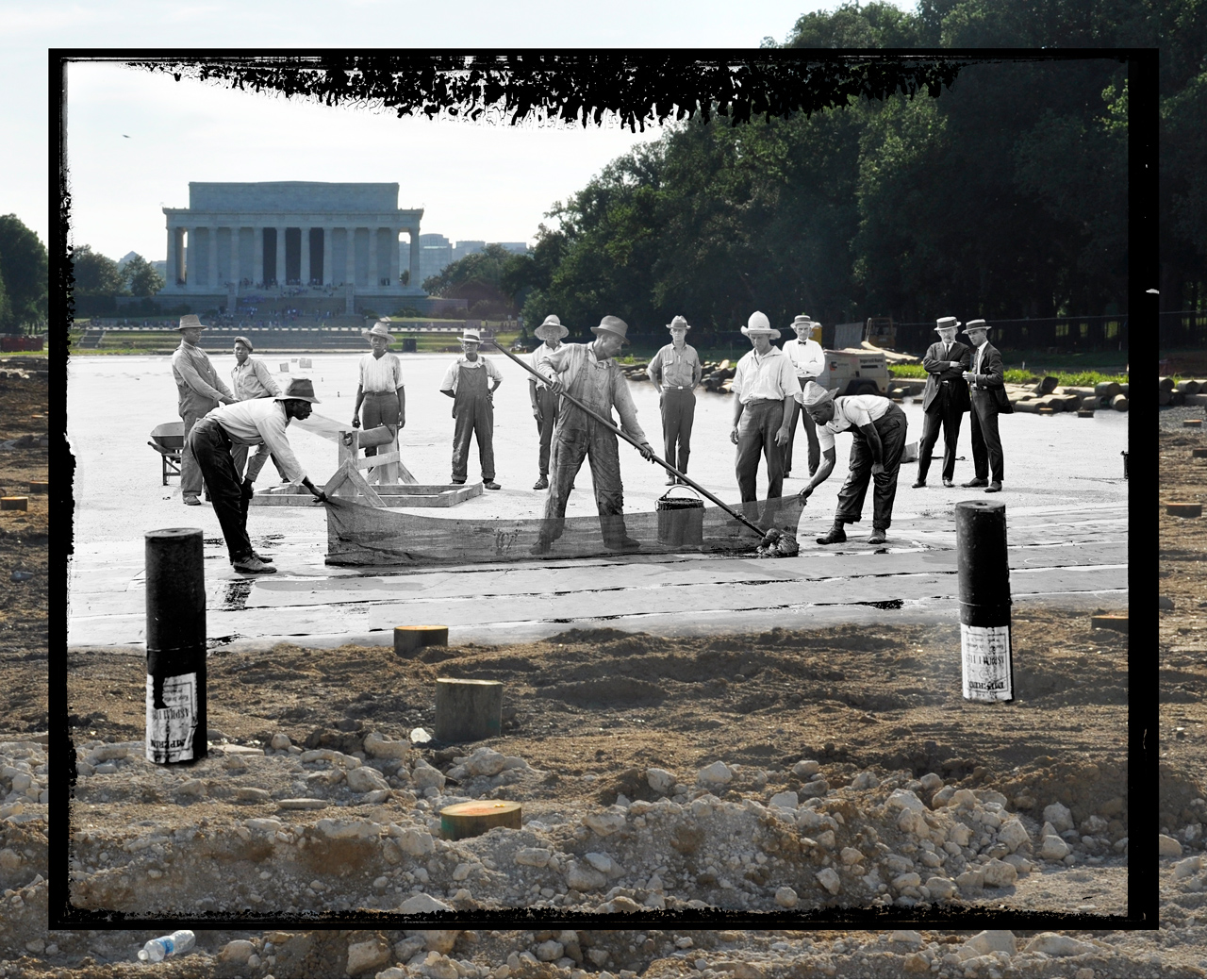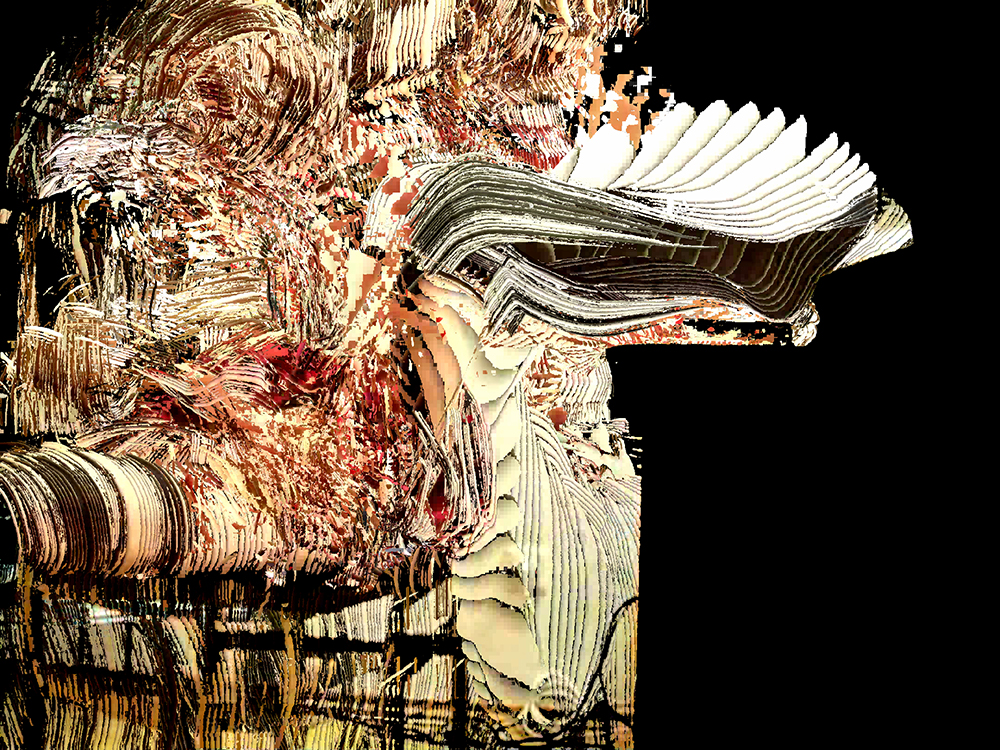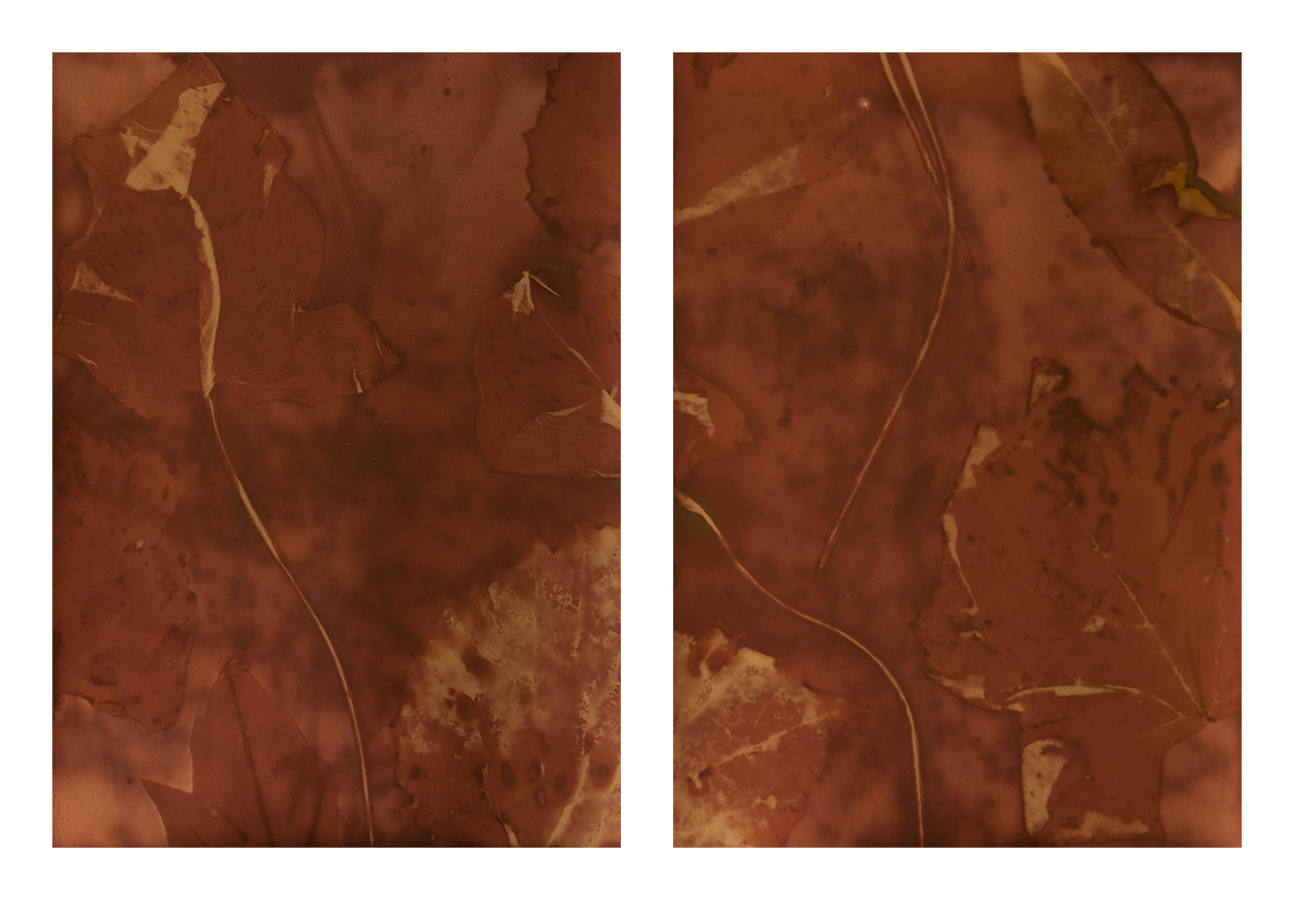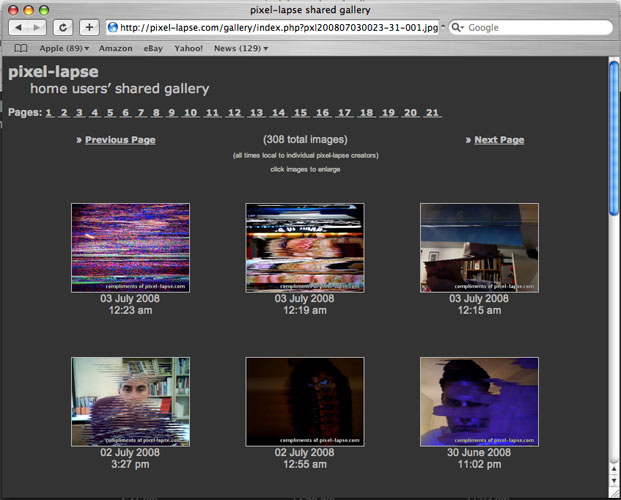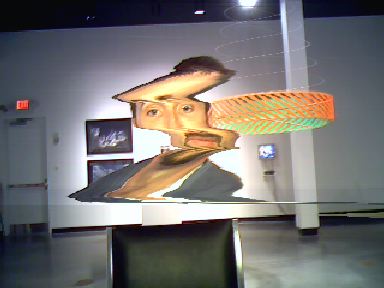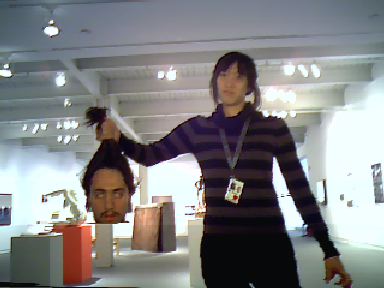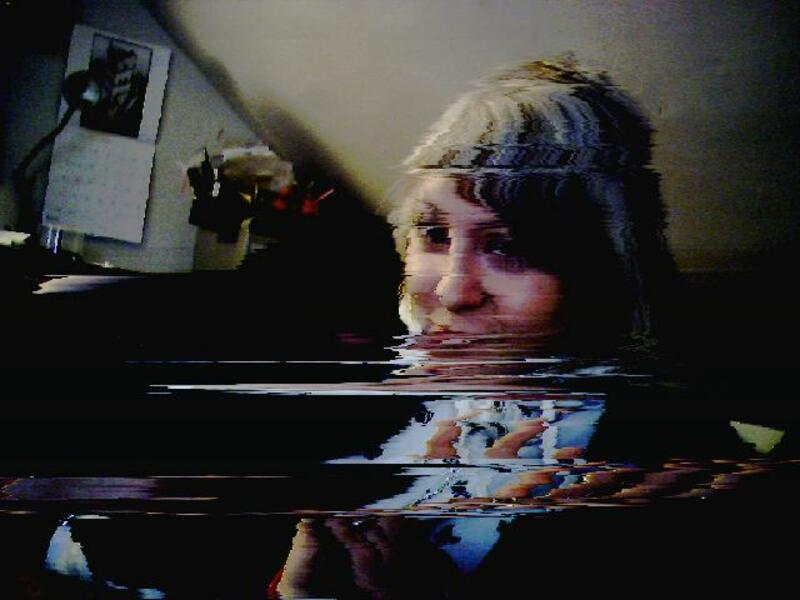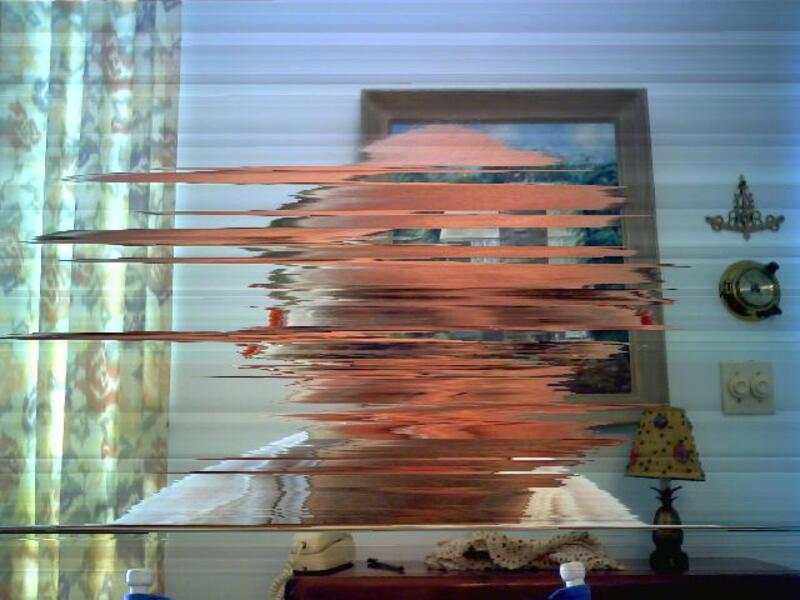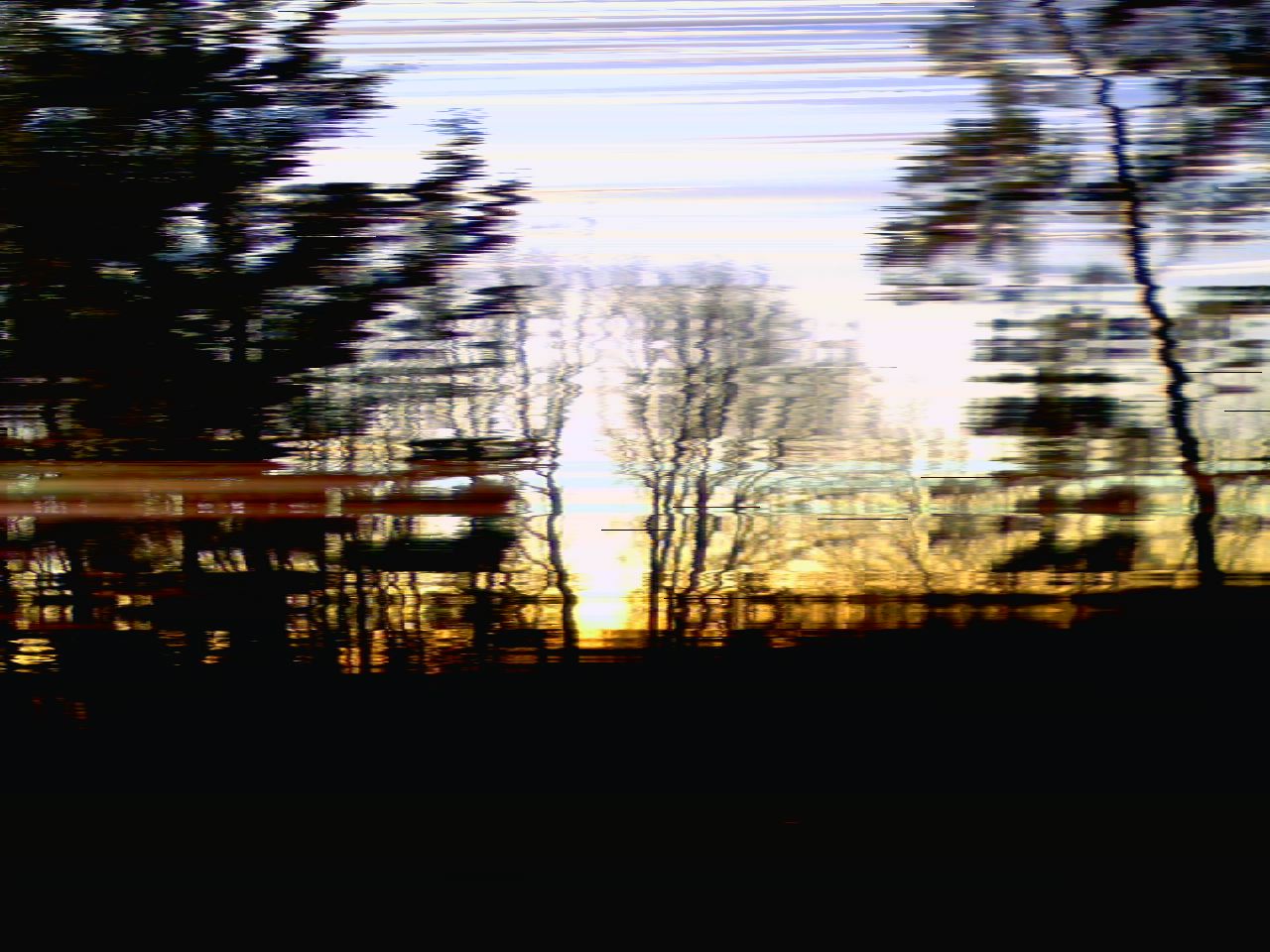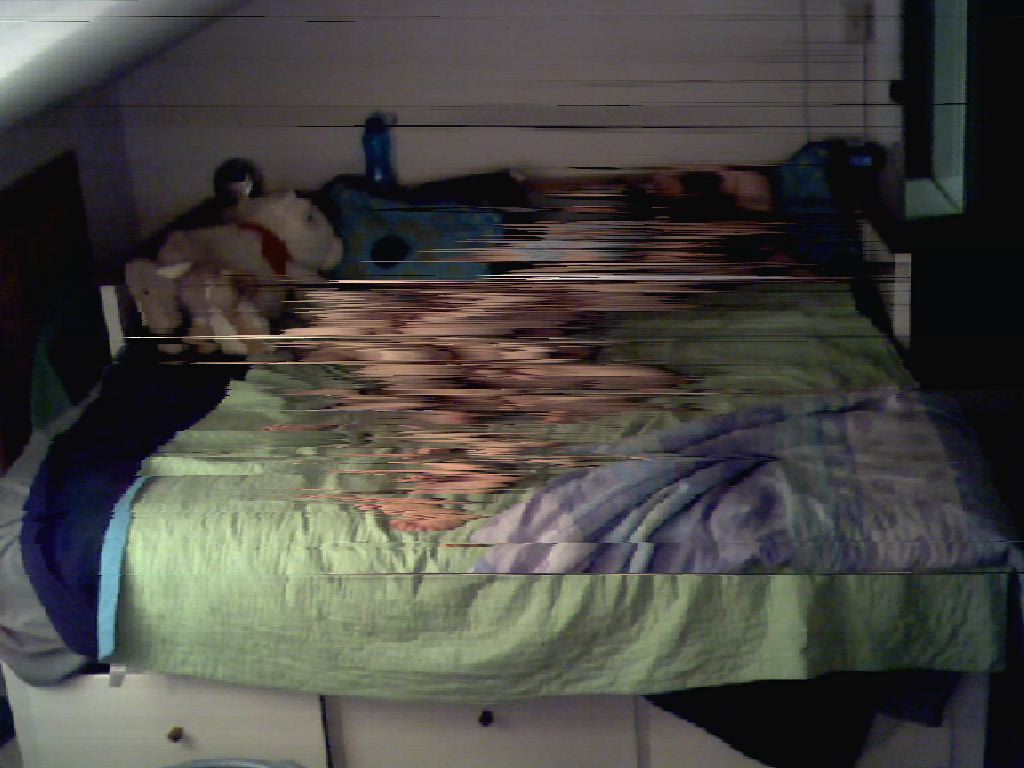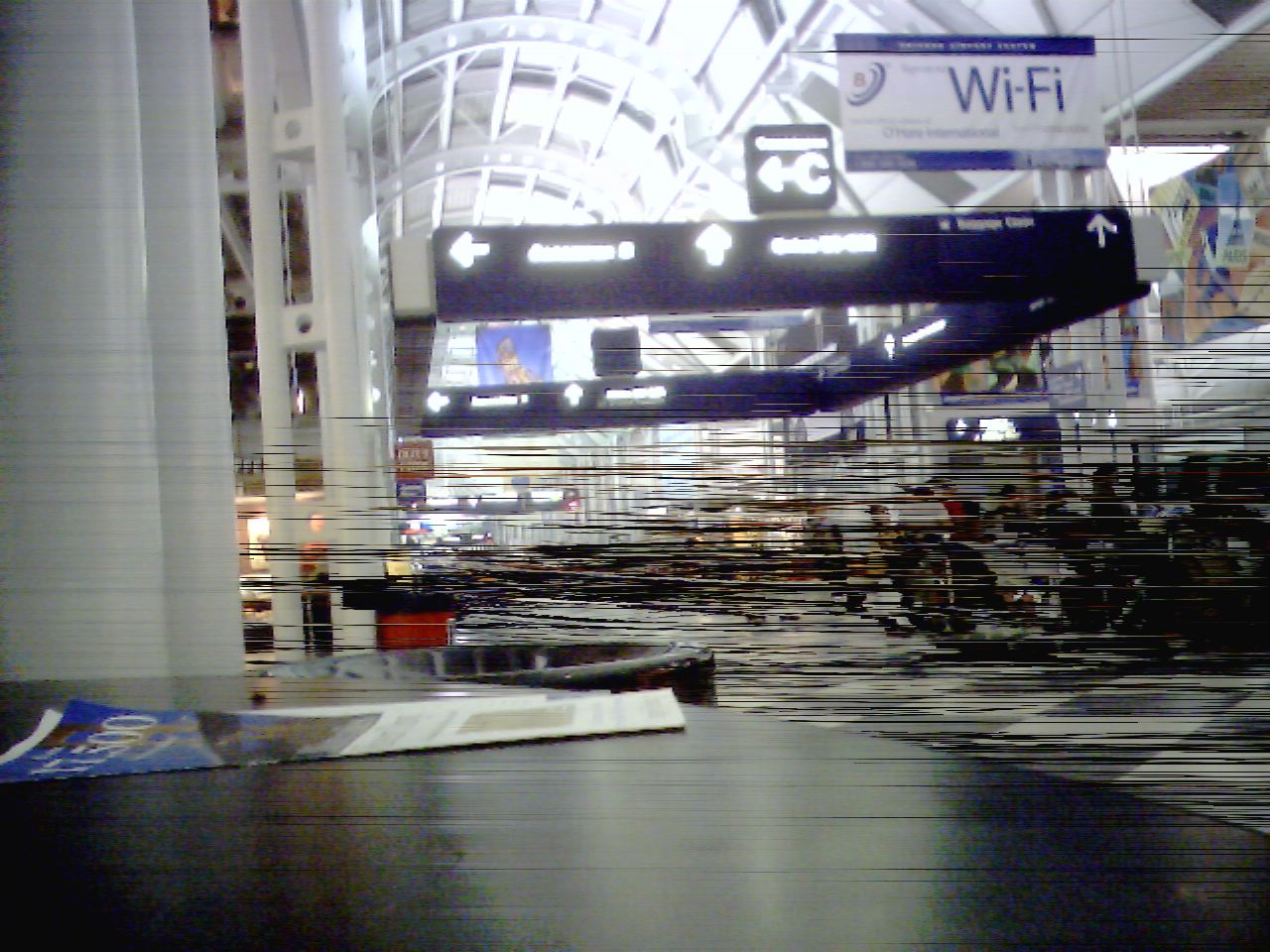Work samples
-
Generative Darkroom
-
Mirror Minus (video overview)
About Steven H
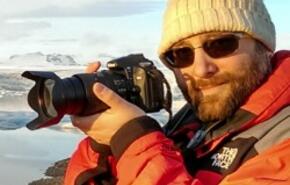
Steven H Silberg is an image-influenced, material-based, process-oriented, cross-media artist with influences ranging from photography to book conservation. Working in image, video, and interactive installation, he engages each medium as a literalist.
His curatorial work employs crowdsourced actions and collaborative practices. In "In Care of The White House," (http://incareofthewhitehouse.org) artists were invited to… more
Jump to a project:
The Generative Darkroom
In a darkroom, an iPhone connected to a laptop over WiFi is placed into an enlarger. A patch written in Max/MSP selects pixels on the iPhone to be illuminated for a specified duration. This is captured on black and white photo paper. The selection of pixels is algorithmic making each image unique.
-
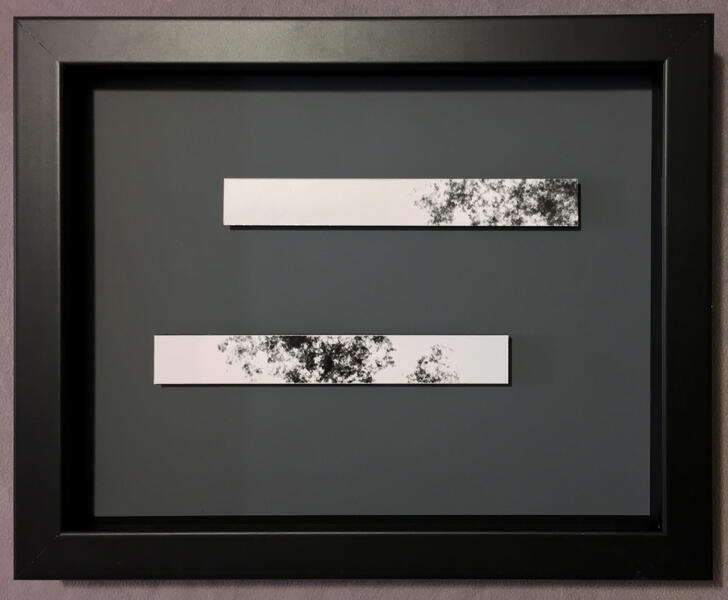 silberg_Construction1.jpgCollage of algorithmically generated photographs on a Delta 1 gray card. (8x10)
silberg_Construction1.jpgCollage of algorithmically generated photographs on a Delta 1 gray card. (8x10) -
 silberg_Construction3.jpgMedium: Collage of algorithmically generated photographs on a Delta 1 gray card (8x10)
silberg_Construction3.jpgMedium: Collage of algorithmically generated photographs on a Delta 1 gray card (8x10) -
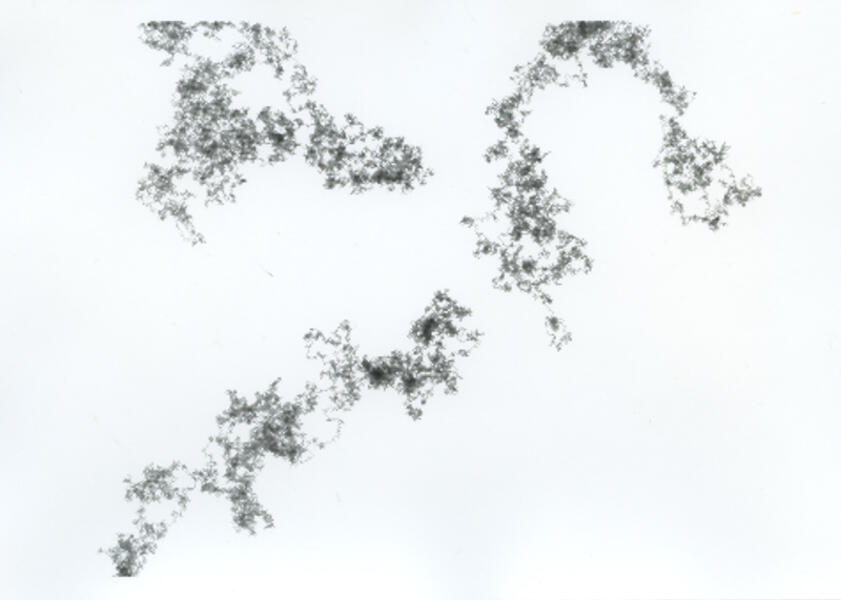 trinary (8/6/15) #2iPhone Pixel Trails on Gelatin Silver Paper
trinary (8/6/15) #2iPhone Pixel Trails on Gelatin Silver Paper -
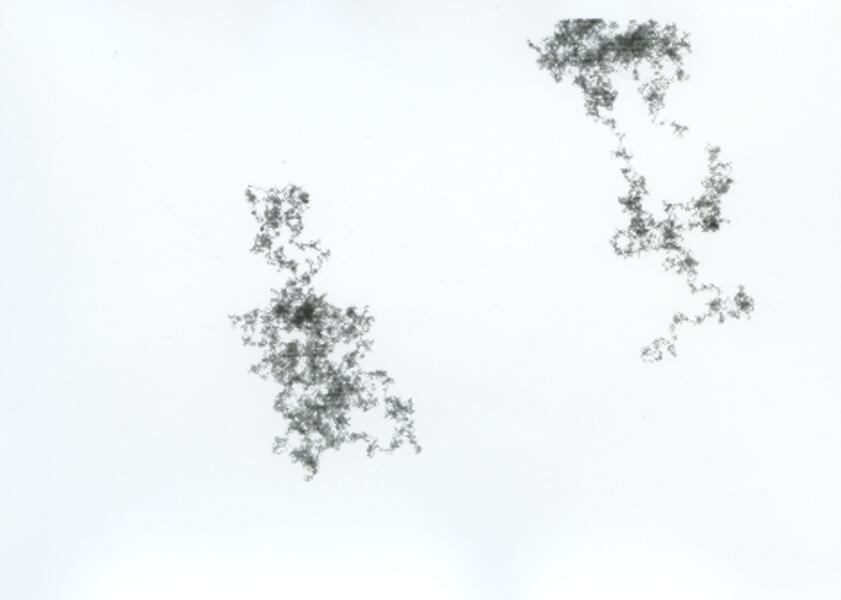 binary (8/6/15) #5iPhone Pixel Trails on Gelatin Silver Paper
binary (8/6/15) #5iPhone Pixel Trails on Gelatin Silver Paper -
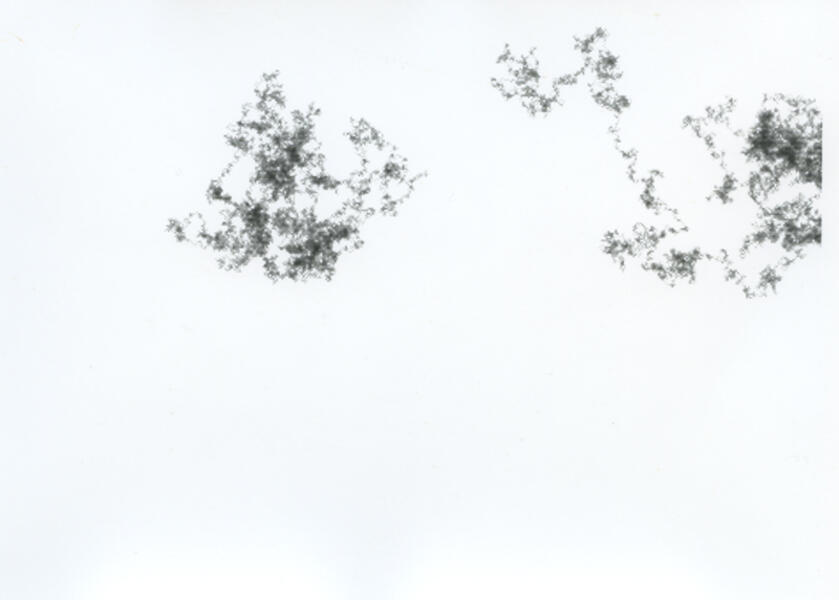 binary (8/6/15) #1iPhone Pixel Trails on Gelatin Silver Paper
binary (8/6/15) #1iPhone Pixel Trails on Gelatin Silver Paper -
 unary (8/6/15) #3iPhone Pixel Trails on Gelatin Silver Paper
unary (8/6/15) #3iPhone Pixel Trails on Gelatin Silver Paper -
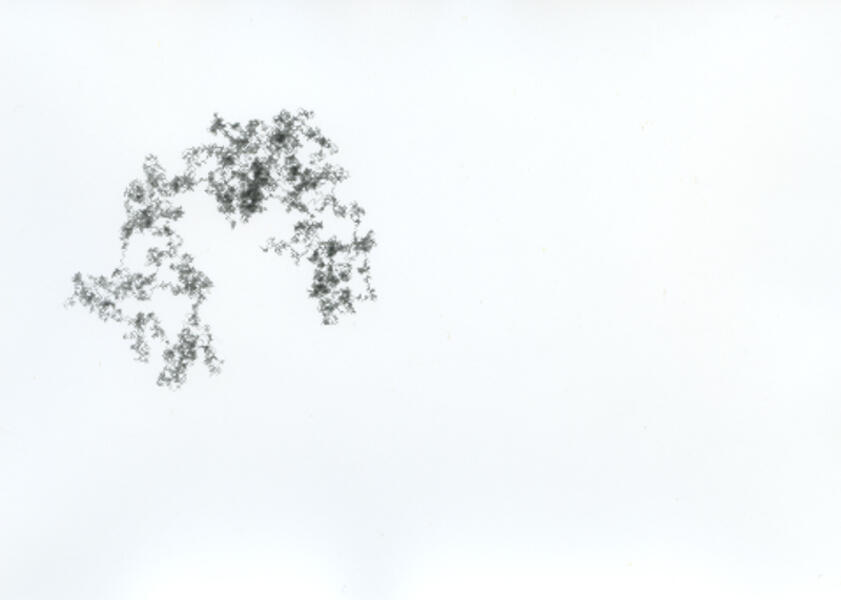 unary (8/6/15) #2iPhone Pixel Trails on Gelatin Silver Paper
unary (8/6/15) #2iPhone Pixel Trails on Gelatin Silver Paper -
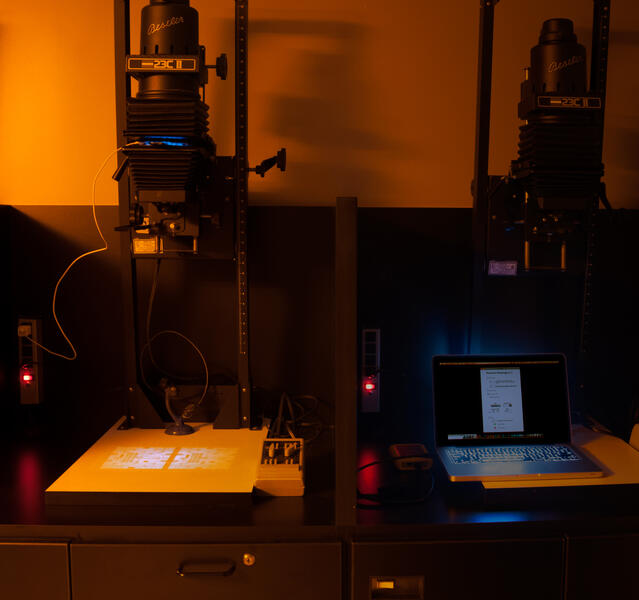 generative-darkroom-composite.jpg
generative-darkroom-composite.jpg -
Generative Darkroom
-
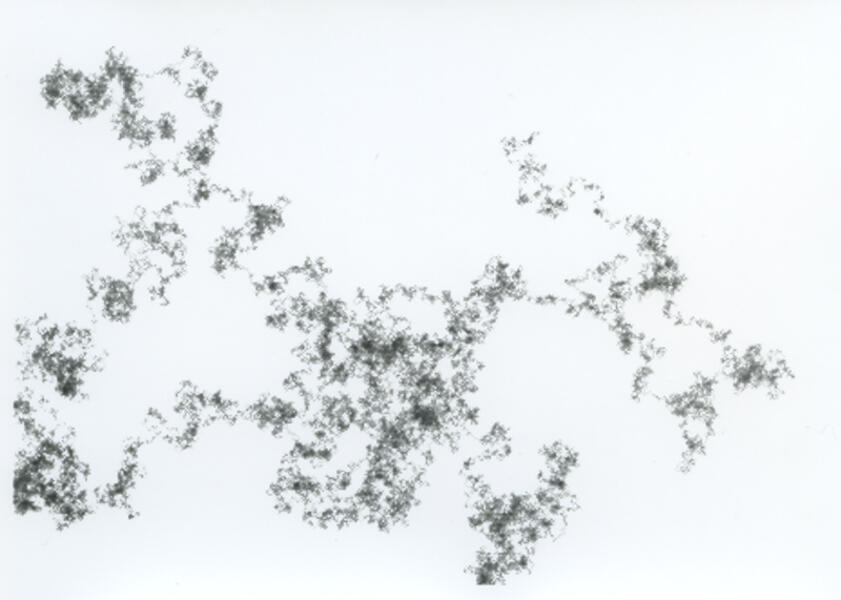 (untitled, 7/28/15) #22iPhone Pixel Trails on Gelatin Silver Paper
(untitled, 7/28/15) #22iPhone Pixel Trails on Gelatin Silver Paper
Curatorial Projects
Included here:
Palimpsest (October-November 2012)
A Washington Project for the Arts Coup d'Espace project
Manipulated & Curated by Steven H Silberg and Neil C Jones.
Participating artists: Jesse Morgan Barnett, Scott Blake, Patterson Clark, Jarrett Davis, Samantha DiRosa, Gary Duehr, Mark Geil, Julee Holcomb, Ryan Hoover, Miyakawa, Michele Montalbano, Matteo Pasin, Jessica Rowshandel, Sarah Sachs, Ali Seley, s/n coalition, Eric Souther, and Erika Stearly.
Hughes Remix (March 2014)
Including over 175 artist submissions
online at hughes-remix.tumblr.com
Sole Connection (December 2006 - Present)
including over 250 stories and image submissions.
online at soleconnection.tumblr.com
Palimpsest (October-November 2012)
A Washington Project for the Arts Coup d'Espace project
Manipulated & Curated by Steven H Silberg and Neil C Jones.
Participating artists: Jesse Morgan Barnett, Scott Blake, Patterson Clark, Jarrett Davis, Samantha DiRosa, Gary Duehr, Mark Geil, Julee Holcomb, Ryan Hoover, Miyakawa, Michele Montalbano, Matteo Pasin, Jessica Rowshandel, Sarah Sachs, Ali Seley, s/n coalition, Eric Souther, and Erika Stearly.
Hughes Remix (March 2014)
Including over 175 artist submissions
online at hughes-remix.tumblr.com
Sole Connection (December 2006 - Present)
including over 250 stories and image submissions.
online at soleconnection.tumblr.com
-
 Image and story received for Sole Connection22 February 2006
Image and story received for Sole Connection22 February 2006
Theresa
"I chose these shoes because they were on my feet for the entire 14 month tour I did for Operation Iraqi Freedom II. I just was able to take them off a few weeks ago and wear some real shoes. But, now that my feet are adjusted to wearing boots, heels are tough to get used to!! I was mobilized on 7 Dec 03 and returned home and discharged from active duty on 6 Feb 05. So, the boot have seen a lot!!"
...more stories at soleconnection.tumblr.com. -
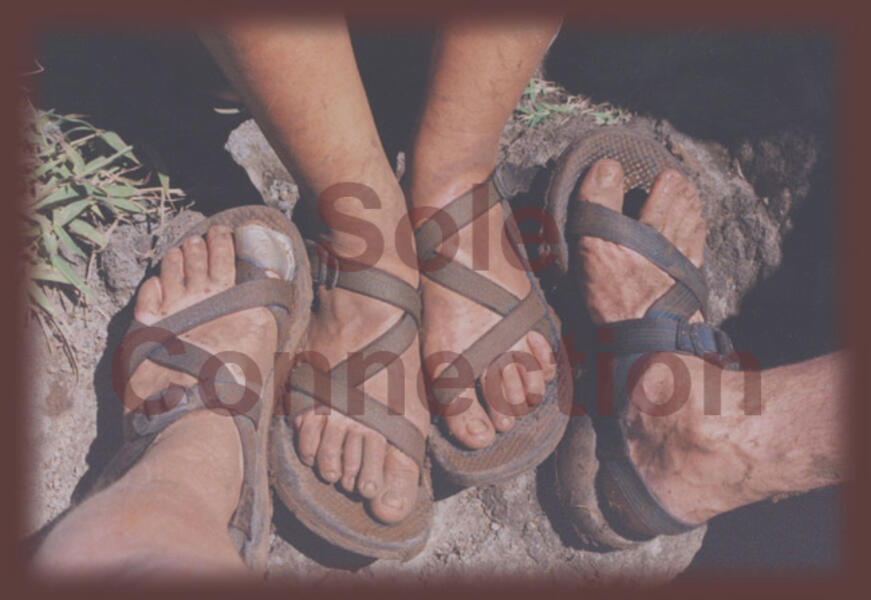 Sole Connection: A Mile in Another’s ShoesSole Connection: A Mile in Another’s Shoes (2006 - Present) Online at soleconnection.tumblr.com.
Sole Connection: A Mile in Another’s ShoesSole Connection: A Mile in Another’s Shoes (2006 - Present) Online at soleconnection.tumblr.com.
“You won’t know a man until you’ve walked a mile in his shoes.” We spend so much of our time not paying attention to each other. When we take the time to share with each other and appreciate the subtleties, we become closer as a community, as a world.
Share your shoes. Share your story. Bare your Sole. ...join the project at soleconnection.tumblr.com. -
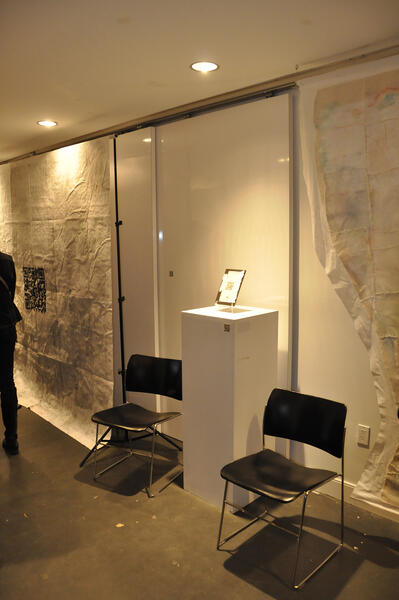 ArtworksScott Blake's "QR Amy Goodman", Miyakawa's "Karmic Layers" (middle), Jessica Rowshandel's "Dear Babies, Please Forgive Me" (right, cut off)
ArtworksScott Blake's "QR Amy Goodman", Miyakawa's "Karmic Layers" (middle), Jessica Rowshandel's "Dear Babies, Please Forgive Me" (right, cut off) -
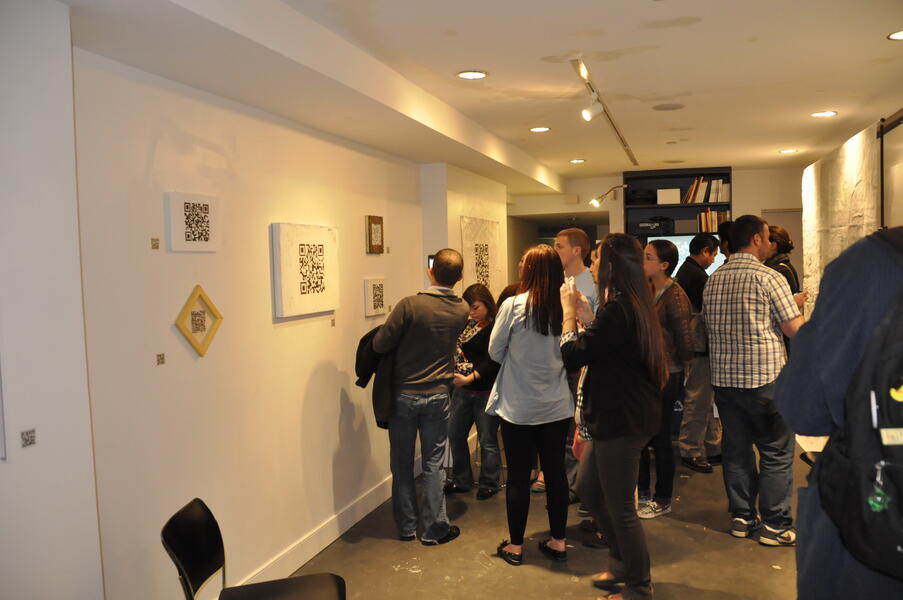 Exhibition viewArtwork by Ryan Hoover, Patterson Clark, Michelle Montalbano, Erika Stearly, Jarrett Davis, and Jesse Morgan Barnett.
Exhibition viewArtwork by Ryan Hoover, Patterson Clark, Michelle Montalbano, Erika Stearly, Jarrett Davis, and Jesse Morgan Barnett. -
 Scanning the ScanningHasan Pitts of s/n Coalition scanning Ali Seley's phone after scanning s/n Coalition's "Beijing Remix"
Scanning the ScanningHasan Pitts of s/n Coalition scanning Ali Seley's phone after scanning s/n Coalition's "Beijing Remix" -
 Scanning the Artwork, Palimpsest (2012)Here, Erika Stearly's painting is being scanned and revealed on an iPhone at the Palimpsest Exhibition (2012)
Scanning the Artwork, Palimpsest (2012)Here, Erika Stearly's painting is being scanned and revealed on an iPhone at the Palimpsest Exhibition (2012) -
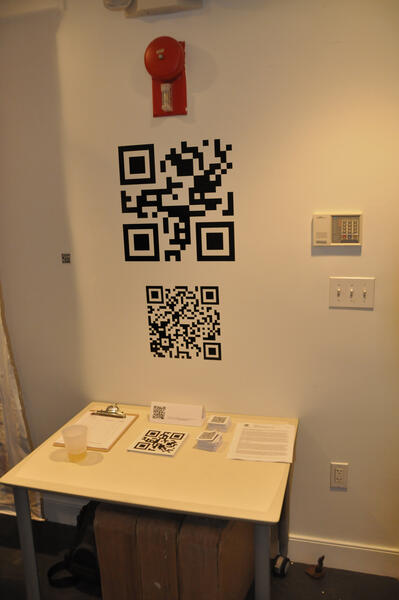 Palimpsest (12 October - 29 November 2012)A Washington Project for the Arts Coup d'Espace project Manipulated & Curated by Steven H Silberg and Neil C Jones. Participating artists: Jesse Morgan Barnett, Scott Blake, Patterson Clark, Jarrett Davis, Samantha DiRosa, Gary Duehr, Mark Geil, Julee Holcomb, Ryan Hoover, Miyakawa, Michele Montalbano, Matteo Pasin, Jessica Rowshandel, Sarah Sachs, Ali Seley, s/n coalition, Eric Souther, and Erika Stearly. From the Press release: "As digital texts—documents, photographs, video—become ubiquitous, we adapt to new ways of reading, adjusting to the layers of information these digital texts contain. In recent years, the QR code has become a common way of relaying additional information, allowing users with the correct technology to access additional data in everything from advertisements and museum exhibitions to business cards and printed books. But what if the QR code became the contemporary representation of information, displacing the original information? It wouldn’t be the first time that newer “text” has superseded the old. Throughout the history of the written word, parchments and vellum have been scraped clean of their original text and reused. Over time, that original text (the scriptio inferior) resurfaces through natural means or scientific research. An immediate relationship between the original text and new text is constructed through their juxtaposition." "Palimpsest alters the experience of viewing individual works of art by forcing viewers to experience the works through the mediation of this new technology. Artwork selected for the exhibition has been documented before being whitewashed or otherwise obliterated. A QR code, which links to the original documentation of the artwork, has been placed on the surface of each individual piece. While the individual works already address the layering of information, the very act of viewing the exhibition will force viewers to experience the layering and mediation the works address. Including work in a range of media—painting, photography, video, and sound—Palimpsest asks what these new methods of representing information mean for artists and their work."
Palimpsest (12 October - 29 November 2012)A Washington Project for the Arts Coup d'Espace project Manipulated & Curated by Steven H Silberg and Neil C Jones. Participating artists: Jesse Morgan Barnett, Scott Blake, Patterson Clark, Jarrett Davis, Samantha DiRosa, Gary Duehr, Mark Geil, Julee Holcomb, Ryan Hoover, Miyakawa, Michele Montalbano, Matteo Pasin, Jessica Rowshandel, Sarah Sachs, Ali Seley, s/n coalition, Eric Souther, and Erika Stearly. From the Press release: "As digital texts—documents, photographs, video—become ubiquitous, we adapt to new ways of reading, adjusting to the layers of information these digital texts contain. In recent years, the QR code has become a common way of relaying additional information, allowing users with the correct technology to access additional data in everything from advertisements and museum exhibitions to business cards and printed books. But what if the QR code became the contemporary representation of information, displacing the original information? It wouldn’t be the first time that newer “text” has superseded the old. Throughout the history of the written word, parchments and vellum have been scraped clean of their original text and reused. Over time, that original text (the scriptio inferior) resurfaces through natural means or scientific research. An immediate relationship between the original text and new text is constructed through their juxtaposition." "Palimpsest alters the experience of viewing individual works of art by forcing viewers to experience the works through the mediation of this new technology. Artwork selected for the exhibition has been documented before being whitewashed or otherwise obliterated. A QR code, which links to the original documentation of the artwork, has been placed on the surface of each individual piece. While the individual works already address the layering of information, the very act of viewing the exhibition will force viewers to experience the layering and mediation the works address. Including work in a range of media—painting, photography, video, and sound—Palimpsest asks what these new methods of representing information mean for artists and their work." -
 Hughes Remix[ curatorial team: Steven H Silberg, Chris Peregoy, Tom Beck ]
Hughes Remix[ curatorial team: Steven H Silberg, Chris Peregoy, Tom Beck ]
The re-presentation of archival images in part or as a whole has become a standard in contemporary photographic practice. Methods are as varied as the artists themselves from Rauschenberg’s inclusion of media images in his prints to Levine’s re-appropriation of FSA photographs and from Fontcuberta’s insertion of himself into archival images to Umbrico’s excising of images from the collective archive.
In conjunction with the 2014 SPE National Conference theme “Collaborative Exchanges: Photography in Dialogue”, The Special Collections Department of the Albin O. Kuhn Library & Gallery and the Department of Visual Arts, at UMBC offered the images of the Hughes Company Glass Negatives Collection for reinterpretation and reinvention.
Full archive of images and project description at the Hughes Remix Tumblr: http://hughes-remix.tumblr.com
This work has been accessioned into the UMBC Albin O. Kuhn Library & Gallery Digital Collections: http://contentdm.ad.umbc.edu/cdm/landingpage/collection/p16629coll16
A short article about the Hughes Remix project was included in Socially Engaged Art Journal. April 2014: http://www.sociallyengagedartjournal.org/2014/04/the-hughes-remix-project/ -
 "Construction: 1922 / 2011"created with images from the Hughes Collection, University of Maryland, Baltimore County. (my submission to the Hughes-Remix project)
"Construction: 1922 / 2011"created with images from the Hughes Collection, University of Maryland, Baltimore County. (my submission to the Hughes-Remix project)
Mirror Minus
“Mirror Minus” is an interactive installation that continues within my experimental process of Reductive Video. The body of work entitled “Reductive Video” borrows the choice to depict changes in movement (either as individual frames or wholly contained in a single image) and applies it to the technical rendering of images. Using custom software written in Max/MSP/Jitter, video is broken down to reveal only the pixels that change from frame to frame, no longer implying form, but instead the shape of what has changed from the previous frame.
-
 Mirror Minus (infinity variation)During the pop-up installation at BRINK creative digital agency in Washington DC (10/22/15-12/7/15), two instances of Mirror minus were installed on opposing walls, allowing the viewer to engage in the space between the projections. This is documentation of one moment as seen by (and projected upon) the two screens.
Mirror Minus (infinity variation)During the pop-up installation at BRINK creative digital agency in Washington DC (10/22/15-12/7/15), two instances of Mirror minus were installed on opposing walls, allowing the viewer to engage in the space between the projections. This is documentation of one moment as seen by (and projected upon) the two screens. -
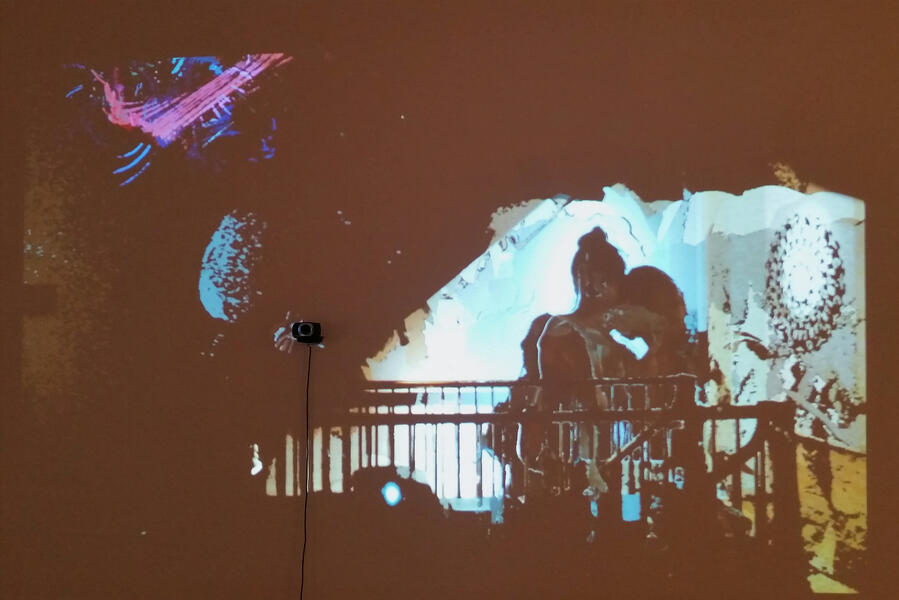 “enjoying a little mother/daughter time at the @a2artcenter.”documentation photo from the installation of this work at the Ann Arbor Art Center, Summer 2015. (via Kimberly Murphy—instragram:_kimmis_)
“enjoying a little mother/daughter time at the @a2artcenter.”documentation photo from the installation of this work at the Ann Arbor Art Center, Summer 2015. (via Kimberly Murphy—instragram:_kimmis_) -
 Yoga in the GalleryDuring installation of “Mirror Minus” at Rosewood Art Center (Kettering, OH), yoga sessions where held in the gallery. Rather than coming as deliberate viewers of the artwork, these participants began to explore the abstract documentation of their movement in relation to their yoga practice. The image on the right of the composite is a screen capture of the projection that appears in the image on the left) Rosewood Art Center, Kettering, OH, 05-02-2014
Yoga in the GalleryDuring installation of “Mirror Minus” at Rosewood Art Center (Kettering, OH), yoga sessions where held in the gallery. Rather than coming as deliberate viewers of the artwork, these participants began to explore the abstract documentation of their movement in relation to their yoga practice. The image on the right of the composite is a screen capture of the projection that appears in the image on the left) Rosewood Art Center, Kettering, OH, 05-02-2014 -
 Mirror MinusThe first documentation from the inaugural installation of this yet untitled interactive artwork, which works on the same principle as my Reductive Video works. Installed at Howard County Arts Center, Ellicott City, Maryland. January 2014-February 2014. Using a webcam, the space is analyzed for changes and those changes are projected back into the space.
Mirror MinusThe first documentation from the inaugural installation of this yet untitled interactive artwork, which works on the same principle as my Reductive Video works. Installed at Howard County Arts Center, Ellicott City, Maryland. January 2014-February 2014. Using a webcam, the space is analyzed for changes and those changes are projected back into the space. -
Mirror Minus (video overview)
-
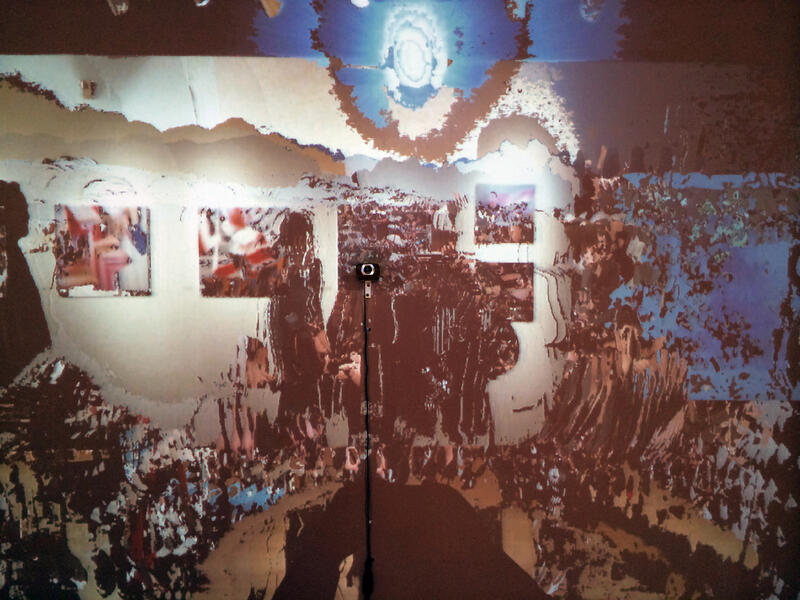 captured documentationPhotograph of the projection created by Mirror Minus while I was documenting the installation.
captured documentationPhotograph of the projection created by Mirror Minus while I was documenting the installation.
For Love
"For Love" represents the reduction of a video into a single print. Similar to the work "After Muybridge, After Marey", the changes in motion and movement are layered to create impressions of these on-screen activities.
The source material is appropriated from online amateur pornographic video-sharing websites.
The source material is appropriated from online amateur pornographic video-sharing websites.
-
 For Love 05110.2" x 13.6" (the dimensions of a 17" computer monitor) printed on uncoated Rives BFK. Hand torn edges. Mounted to "float" against the wall.
For Love 05110.2" x 13.6" (the dimensions of a 17" computer monitor) printed on uncoated Rives BFK. Hand torn edges. Mounted to "float" against the wall. -
 For Love 02010.2" x 13.6" (the dimensions of a 17" computer monitor) printed on uncoated Rives BFK. Hand torn edges. Mounted to "float" against the wall.
For Love 02010.2" x 13.6" (the dimensions of a 17" computer monitor) printed on uncoated Rives BFK. Hand torn edges. Mounted to "float" against the wall. -
 For Love 07110.2" x 13.6" (the dimensions of a 17" computer monitor) printed on uncoated Rives BFK. Hand torn edges. Mounted to "float" against the wall.
For Love 07110.2" x 13.6" (the dimensions of a 17" computer monitor) printed on uncoated Rives BFK. Hand torn edges. Mounted to "float" against the wall. -
 For Love 089-b10.2" x 13.6" (the dimensions of a 17" computer monitor) printed on uncoated Rives BFK. Hand torn edges. Mounted to "float" against the wall. This image was selected by Maryland Art Place for their IMPRINT program in 2014. ( more info at http://mdartplace.org/opportunities/imprint )
For Love 089-b10.2" x 13.6" (the dimensions of a 17" computer monitor) printed on uncoated Rives BFK. Hand torn edges. Mounted to "float" against the wall. This image was selected by Maryland Art Place for their IMPRINT program in 2014. ( more info at http://mdartplace.org/opportunities/imprint ) -
 For Love 12910.2" x 13.6" (the dimensions of a 17" computer monitor) printed on uncoated Rives BFK. Hand torn edges. Mounted to "float" against the wall.
For Love 12910.2" x 13.6" (the dimensions of a 17" computer monitor) printed on uncoated Rives BFK. Hand torn edges. Mounted to "float" against the wall. -
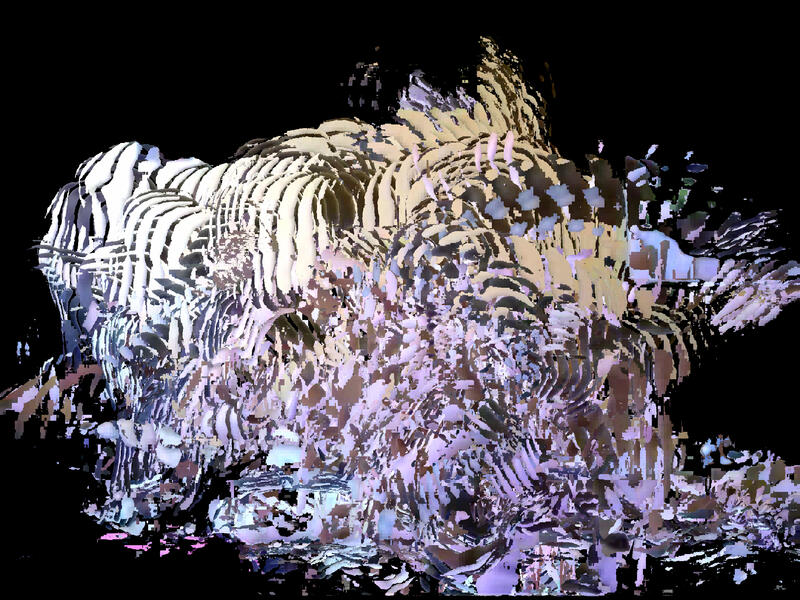 For Love 00310.2" x 13.6" (the dimensions of a 17" computer monitor) printed on uncoated Rives BFK. Hand torn edges. Mounted to "float" against the wall.
For Love 00310.2" x 13.6" (the dimensions of a 17" computer monitor) printed on uncoated Rives BFK. Hand torn edges. Mounted to "float" against the wall. -
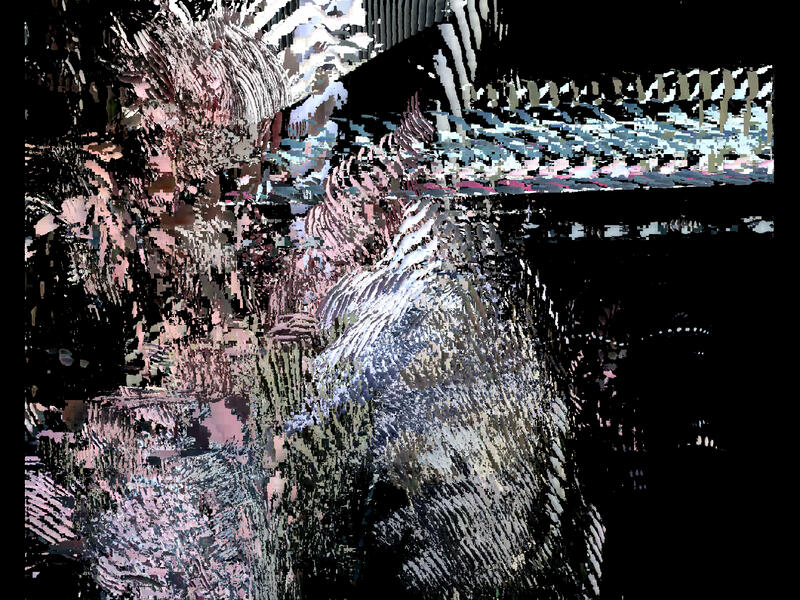 For Love 04110.2" x 13.6" (the dimensions of a 17" computer monitor) printed on uncoated Rives BFK. Hand torn edges. Mounted to "float" against the wall.
For Love 04110.2" x 13.6" (the dimensions of a 17" computer monitor) printed on uncoated Rives BFK. Hand torn edges. Mounted to "float" against the wall. -
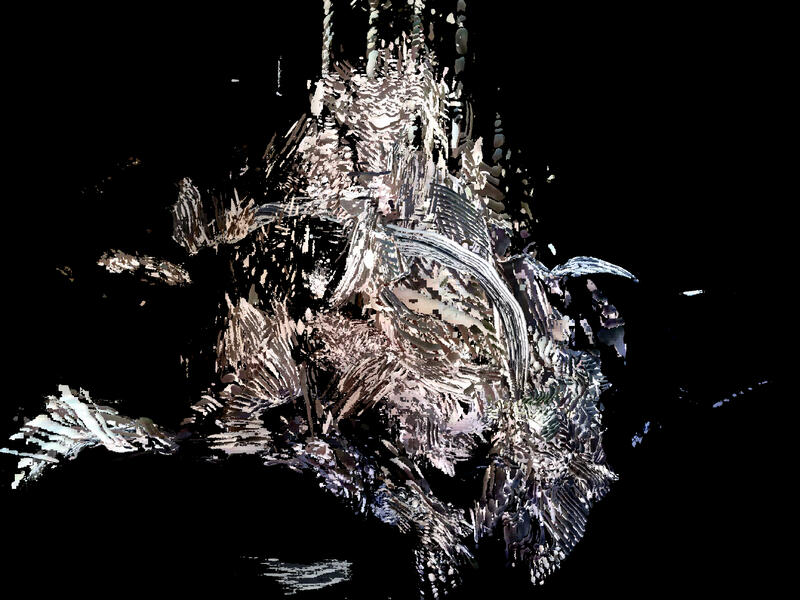 For Love 01510.2" x 13.6" (the dimensions of a 17" computer monitor) printed on uncoated Rives BFK. Hand torn edges. Mounted to "float" against the wall.
For Love 01510.2" x 13.6" (the dimensions of a 17" computer monitor) printed on uncoated Rives BFK. Hand torn edges. Mounted to "float" against the wall. -
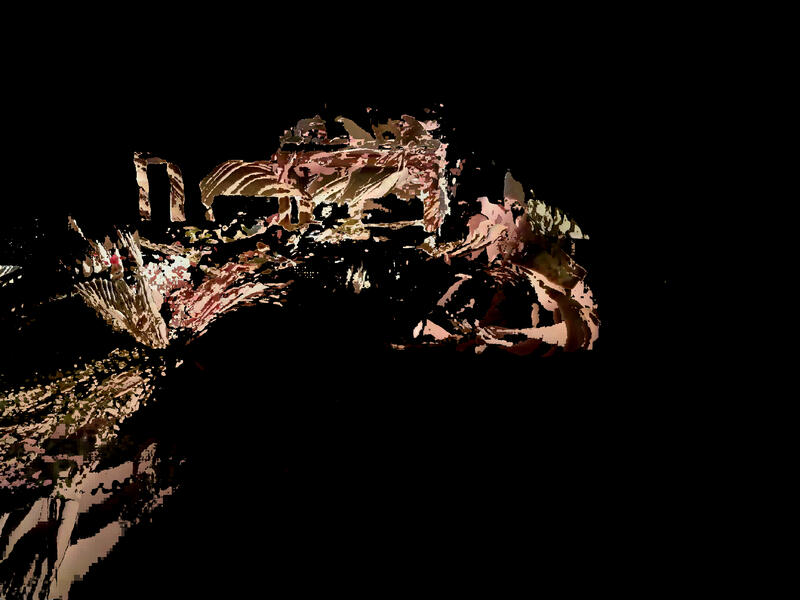 For Love 08410.2" x 13.6" (the dimensions of a 17" computer monitor) printed on uncoated Rives BFK. Hand torn edges. Mounted to "float" against the wall.
For Love 08410.2" x 13.6" (the dimensions of a 17" computer monitor) printed on uncoated Rives BFK. Hand torn edges. Mounted to "float" against the wall. -
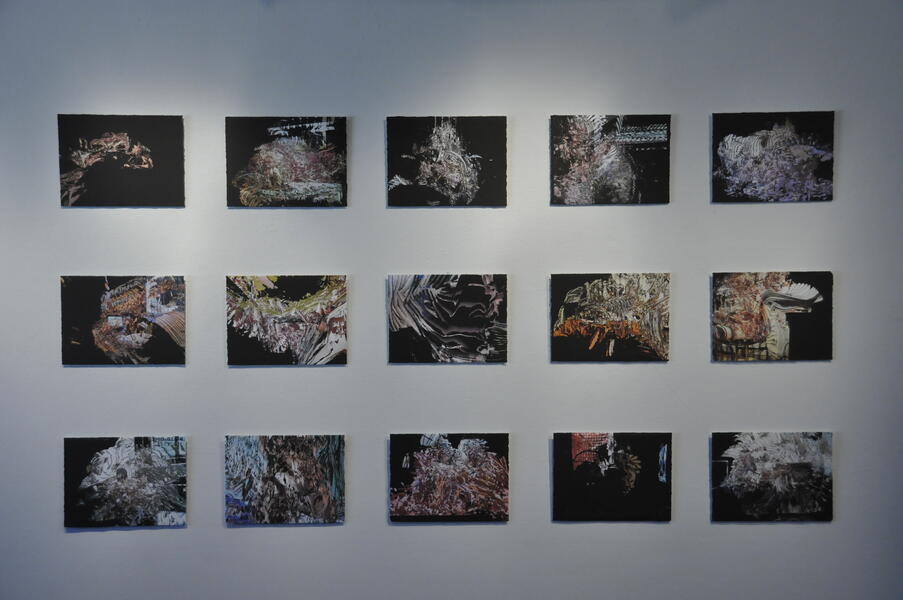 For Love (installed)15 images (each 10.2" x 13.6" - the dimensions of a 17" computer monitor) printed on uncoated Rives BFK. Hand torn edges. Mounted to "float" against the wall.
For Love (installed)15 images (each 10.2" x 13.6" - the dimensions of a 17" computer monitor) printed on uncoated Rives BFK. Hand torn edges. Mounted to "float" against the wall.
Reductive Video: "After Muybridge, After Marey" & "Location Studies"
These experiments in "Reductive Video" are an homage to the work of Eadweard Muybridge, Etienne-Jules Marey, and Thomas Eakins, bringing their ideas into the 21st century by highlighting the changes in motion and movement as experienced and recorded by technology. Video is captured and processed, comparing one frame of video against the next. Only those pixels that differ from the previous frame are then displayed. These changes are then also compiled into a single print. By presenting video and print side-by-side, viewers are able to both isolate motion and experience the whole event in an instant.
-
Reductive Video Location Study: Mount Royal Lightrail Station"Experiments in Reductive Video" moves the work of Eadweard Muybridge, Etienne-Jules Marey, and Thomas Eakins into the 21st century, highlighting the changes in motion and movement as experienced and recorded by technology. Video of a person, place, or action is captured and processed, comparing one frame of video against the next. Only those pixels that differ from the previous frame are then displayed. These changes are then compiled into a single print. By presenting video and print side-by-side, viewers are able to both isolate motion and experience the whole event in an instant.
-
Reductive Video Location Studies: Cape Neddick, Maine"Experiments in Reductive Video" moves the work of Eadweard Muybridge, Etienne-Jules Marey, and Thomas Eakins into the 21st century, highlighting the changes in motion and movement as experienced and recorded by technology. Video of a person, place, or action is captured and processed, comparing one frame of video against the next. Only those pixels that differ from the previous frame are then displayed. These changes are then compiled into a single print. By presenting video and print side-by-side, viewers are able to both isolate motion and experience the whole event in an instant.
-
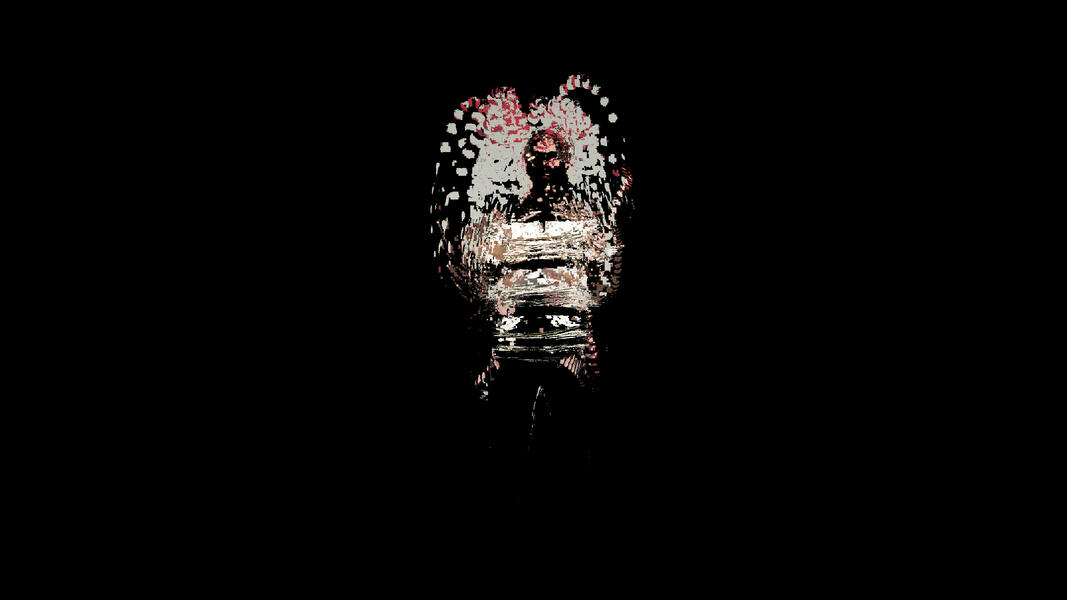 After Muybridge, After Marey: Male Juggler - Anterior View, 2010Print. presented with partner video. dimensions variable (ranging from 16" x 9" to 32" x 18") printed on uncoated Rives BFK. Hand torn edges. Mounted to "float" against the wall.
After Muybridge, After Marey: Male Juggler - Anterior View, 2010Print. presented with partner video. dimensions variable (ranging from 16" x 9" to 32" x 18") printed on uncoated Rives BFK. Hand torn edges. Mounted to "float" against the wall. -
After Muybridge, After Marey: Male Juggler - Anterior View, 2010partner video for print: "Male Juggler - Anterior View, 2010"
-
 After Muybridge, After Marey: Female Cyclist - Left Lateral View, 2009Print. presented with partner video. dimensions variable (ranging from 16" x 9" to 32" x 18") printed on uncoated Rives BFK. Hand torn edges. Mounted to "float" against the wall.
After Muybridge, After Marey: Female Cyclist - Left Lateral View, 2009Print. presented with partner video. dimensions variable (ranging from 16" x 9" to 32" x 18") printed on uncoated Rives BFK. Hand torn edges. Mounted to "float" against the wall. -
After Muybridge, After Marey: Female Cyclist - Left Lateral View, 2009partner video for print: "Female Cyclist - Left Lateral View, 2009"
-
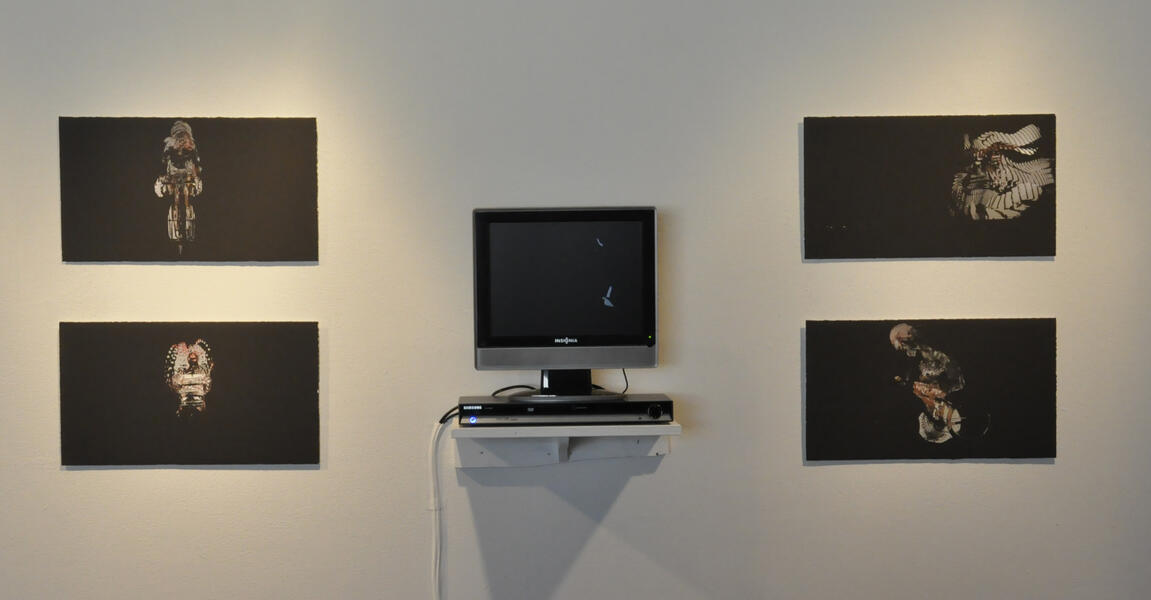 After Muybridge, After Marey - installedsmall installation of After Muybridge, After Marey - 4 images flanking the 4 partner videos (played in sequence on one screen)
After Muybridge, After Marey - installedsmall installation of After Muybridge, After Marey - 4 images flanking the 4 partner videos (played in sequence on one screen) -
After Muybridge, After Marey - overviewAn overview of the reductive video process as used in "After Muybridge, After Marey"
Lumen Prints
For the past few years, I have been exploring the Lumen print process - long exposure on photographic paper without development.
Some items are fixed (which changes the color of the image but offers permanence).
Some items are photographs of the lumen prints for inkjet printing. Those originals are sealed away in light tight boxes.
Some items are fixed (which changes the color of the image but offers permanence).
Some items are photographs of the lumen prints for inkjet printing. Those originals are sealed away in light tight boxes.
-
 Mr. ChillatoLumen print on RC paper from digital paper negative.
Mr. ChillatoLumen print on RC paper from digital paper negative.
Fixed for permanence. -
 Banana peel on 2 overcast days7/10/13-7/11/13
Banana peel on 2 overcast days7/10/13-7/11/13
Lumen print of a banana peel exposed across 2 overcast days with overnight rain (6pm-9am)
Kodabromide
single weight
E2
Unfixed -
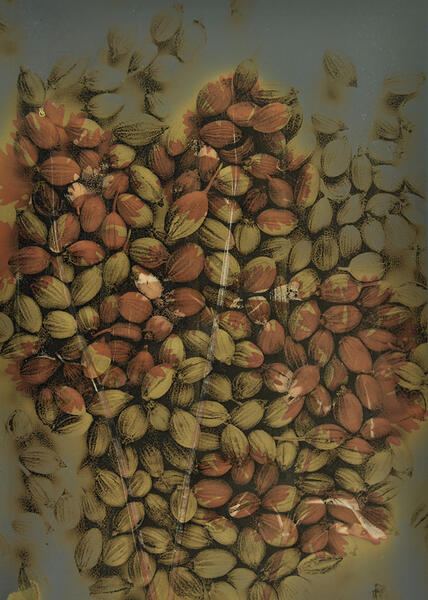 Cilantro on Coriander5/17/13
Cilantro on Coriander5/17/13
Lumen Print of Cilantro leaves over inkjet image of coriander seeds.
Ilford
Warm Tone
Fiber
Glossy
Unfixed -
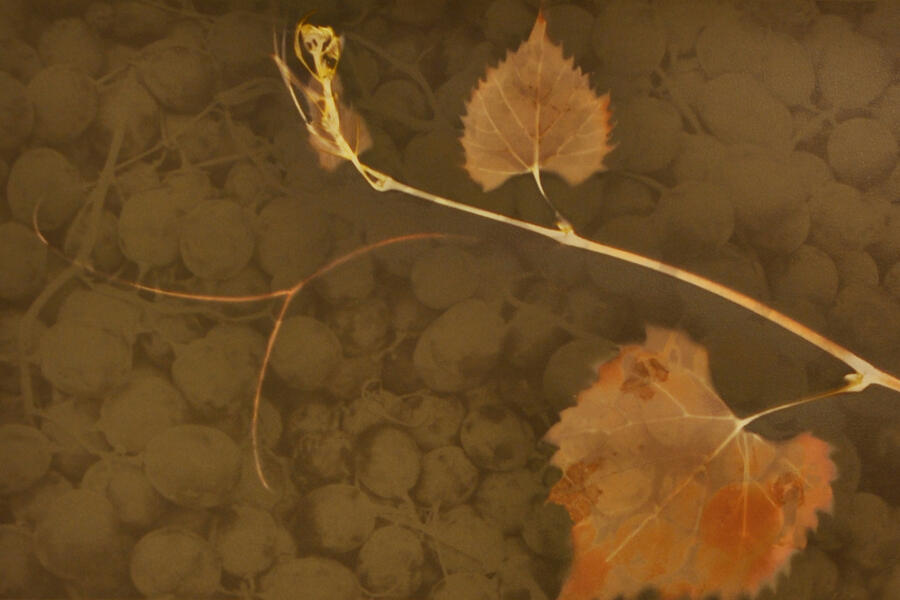 Grape Leaves on Grapes5/30/13
Grape Leaves on Grapes5/30/13
Lumen Print of Grape leaves over inkjet image of grapes.
Agfa
Portriga-Rapid PRK 118
Fine-Grained Matt
Unfixed -
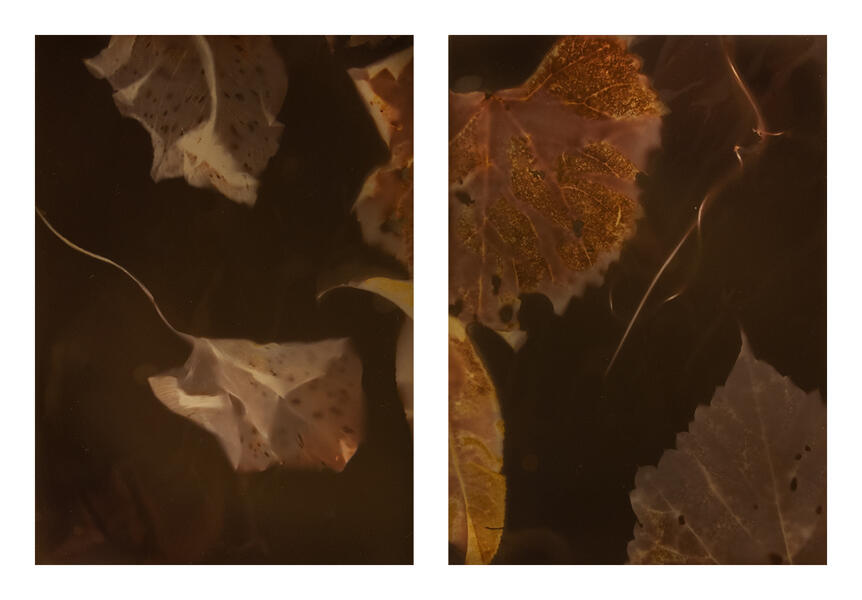 Autumn 10/15/201312 hour exposure on
Autumn 10/15/201312 hour exposure on
Agfa
MultiContrast Premium MCP310RC
Glossy
Unfixed -
 Twenty-four Hours of Autumn Shade10/15/2013 - 10/16/2013
Twenty-four Hours of Autumn Shade10/15/2013 - 10/16/2013
Exposed by leaving in an area that in shaded during the entire day from 9:10pm to 9:10pm
Forte
PolyWarmtone Art
Ivory Base
Unfixed
[Produced as part of my collaboration for The Light Ekphrastic (Nov. 2013): http://thelightekphrastic.com/issues/november-2013-issue-16/porter-silberg-nov-13/ ]
Pixel-Lapse (photobooth)
"Pixel-lapse" photography is the process of creating an image one pixel at a time. Beginning in the upper left corner, pixels are captured sequentially at a set rate until the entire image is formed.
"Pixel-lapse" combines the temporal nature of long exposure photography and the precise organization of the digital matrix. By creating an image one pixel at a time, each part of the image shows different captured moments. In the end, each image not only has dimension but also gains duration and velocity. When the image is complete, we are left with the experience of the passing of time, abstracted by the inability to view the sum total of the event or experience.
The pixel-lapse project has three current iterations: (1) images created by the artist (including portraits), (2) a full sized interactive photo booth installation, and (3) a downloadable home version of the photo booth.
Please visit http://www.pixel-lapse.com to download the software (PC and Mac) and view the various shared galleries.
"Pixel-lapse" combines the temporal nature of long exposure photography and the precise organization of the digital matrix. By creating an image one pixel at a time, each part of the image shows different captured moments. In the end, each image not only has dimension but also gains duration and velocity. When the image is complete, we are left with the experience of the passing of time, abstracted by the inability to view the sum total of the event or experience.
The pixel-lapse project has three current iterations: (1) images created by the artist (including portraits), (2) a full sized interactive photo booth installation, and (3) a downloadable home version of the photo booth.
Please visit http://www.pixel-lapse.com to download the software (PC and Mac) and view the various shared galleries.
-
 home users' shared gallery at pixel-lapse.com (screen capture)When users of the home version of the pixel-lapse photo booth select "Share Image", completed pixel-lapse photos are automatically uploaded to the home users' shared gallery at pixel-lapse.com
home users' shared gallery at pixel-lapse.com (screen capture)When users of the home version of the pixel-lapse photo booth select "Share Image", completed pixel-lapse photos are automatically uploaded to the home users' shared gallery at pixel-lapse.com
Visit http://www.pixel-lapse.com to download a version of pixel-lapse that you can run on your own computer. Share your images in the online gallery. -
 Pixel-Lapse Photo Booth, home user's version (screen capture)Visit http://www.pixel-lapse.com to download a version of pixel-lapse that you can run on your own computer. Share your images in the online gallery.
Pixel-Lapse Photo Booth, home user's version (screen capture)Visit http://www.pixel-lapse.com to download a version of pixel-lapse that you can run on your own computer. Share your images in the online gallery. -
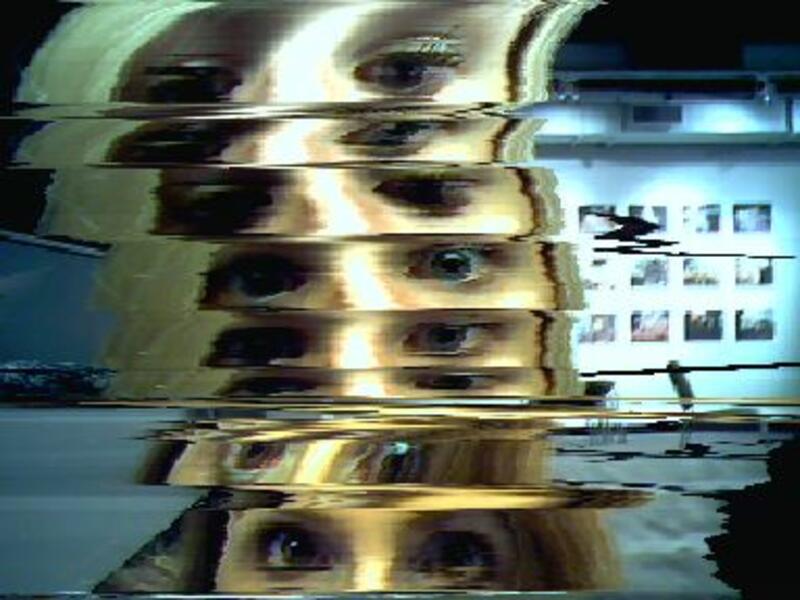 Image created in the Photo Booth installed at the Creative Alliance, Baltimore. Fall 2010A full archive of images from all exhibitions can be found at http://pixel-lapse.com/installation.htm
Image created in the Photo Booth installed at the Creative Alliance, Baltimore. Fall 2010A full archive of images from all exhibitions can be found at http://pixel-lapse.com/installation.htm -
 Image created in the Photo Booth installed at DCCA, Summer 2010A full archive of images from all exhibitions can be found at http://pixel-lapse.com/installation.htm
Image created in the Photo Booth installed at DCCA, Summer 2010A full archive of images from all exhibitions can be found at http://pixel-lapse.com/installation.htm -
 Image created in the Photo Booth installed at MICA's Decker Gallery, Fall 2009A full archive of images from all exhibitions can be found at http://pixel-lapse.com/installation.htm
Image created in the Photo Booth installed at MICA's Decker Gallery, Fall 2009A full archive of images from all exhibitions can be found at http://pixel-lapse.com/installation.htm -
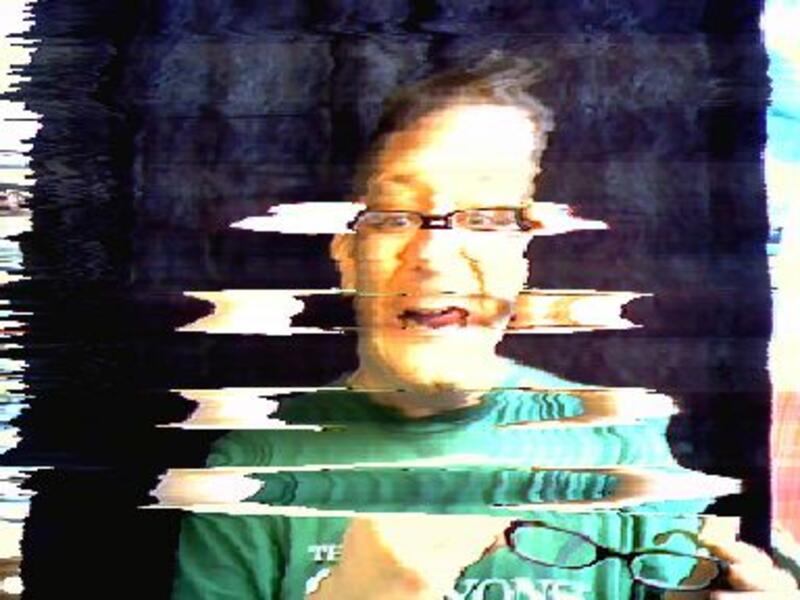 Image created in the Photo Booth installed at ArtScape, Baltimore 2009A full archive of images from all exhibitions can be found at http://pixel-lapse.com/installation.htm
Image created in the Photo Booth installed at ArtScape, Baltimore 2009A full archive of images from all exhibitions can be found at http://pixel-lapse.com/installation.htm -
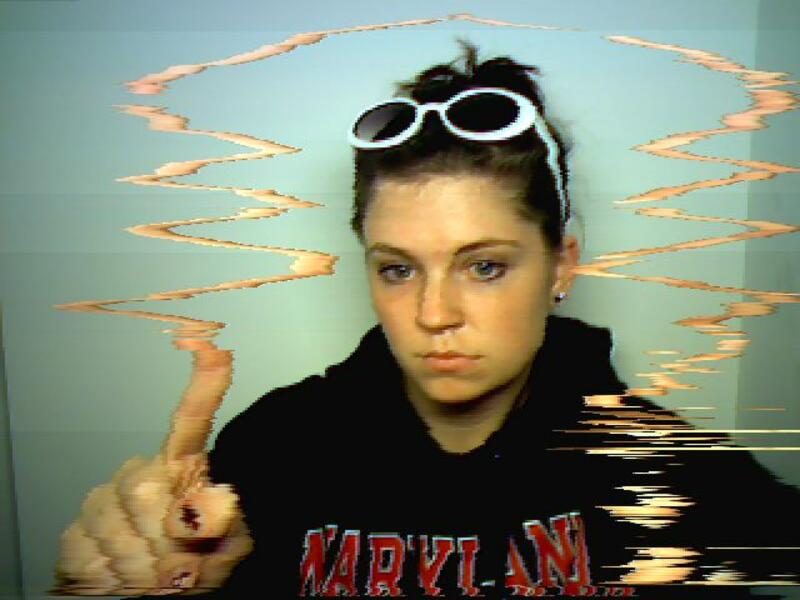 Image created in the Photo Booth installed at University of MD, Oct 2008A full archive of images from all exhibitions can be found at http://pixel-lapse.com/installation.htm
Image created in the Photo Booth installed at University of MD, Oct 2008A full archive of images from all exhibitions can be found at http://pixel-lapse.com/installation.htm -
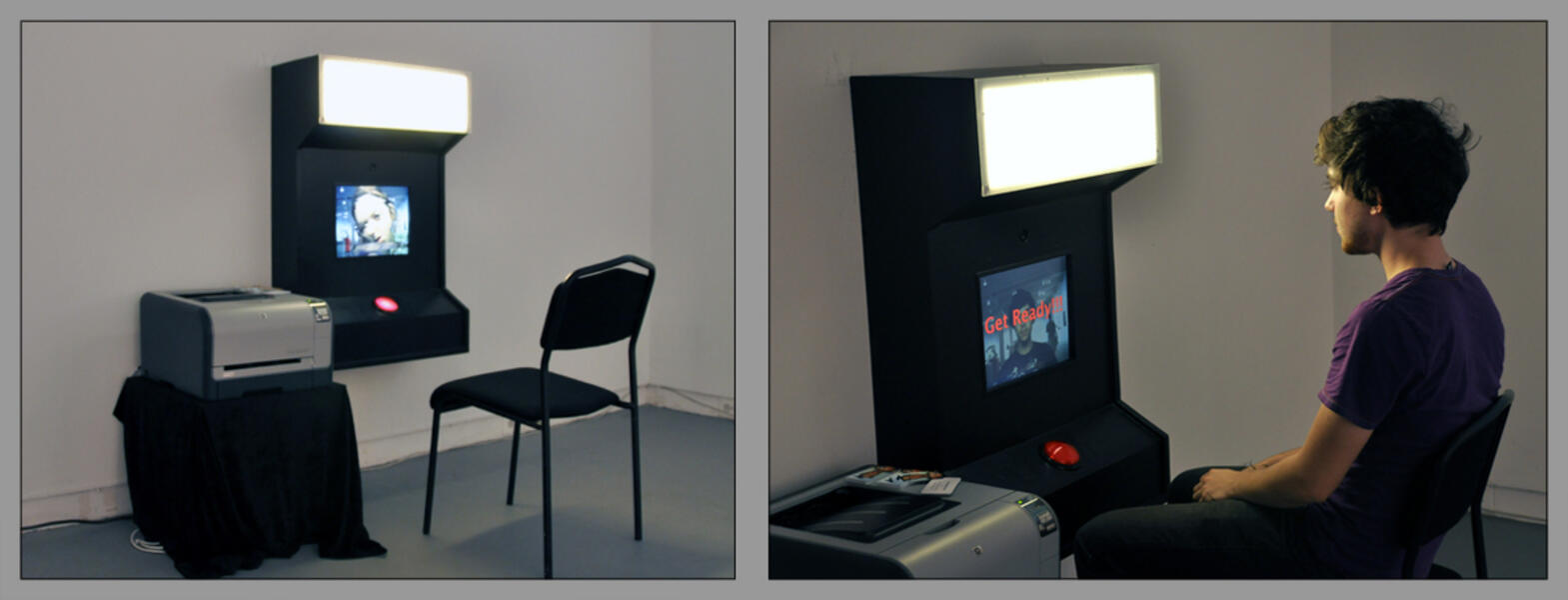 Pixel-Lapse Photo Booth, MICA, Fall 2009
Pixel-Lapse Photo Booth, MICA, Fall 2009 -
Pixel-lapse Photo Booth Documentation
-
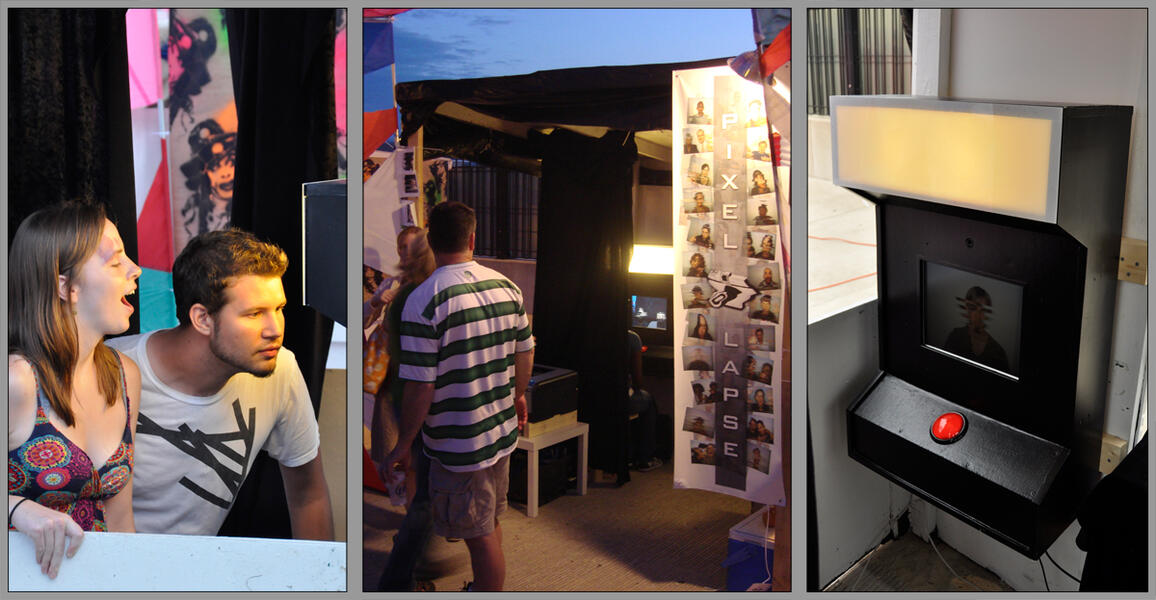 Pixel-Lapse Photo Booth, Artscape 2009
Pixel-Lapse Photo Booth, Artscape 2009
Pixel-Lapse
"Pixel-lapse" photography is the process of creating an image one pixel at a time. Beginning in the upper left corner, pixels are captured sequentially at a set rate until the entire image is formed.
"Pixel-lapse" combines the temporal nature of long exposure photography and the precise organization of the digital matrix. By creating an image one pixel at a time, each part of the image shows different captured moments. In the end, each image not only has dimension but also gains duration and velocity. When the image is complete, we are left with the experience of the passing of time, abstracted by the inability to view the sum total of the event or experience.
The pixel-lapse project has three current iterations: (1) images created by the artist (including portraits), (2) a full sized interactive photo booth installation, and (3) a downloadable home version of the photo booth.
Please visit http://www.pixel-lapse.com to download the software (PC and Mac) and view the various shared galleries.
"Pixel-lapse" combines the temporal nature of long exposure photography and the precise organization of the digital matrix. By creating an image one pixel at a time, each part of the image shows different captured moments. In the end, each image not only has dimension but also gains duration and velocity. When the image is complete, we are left with the experience of the passing of time, abstracted by the inability to view the sum total of the event or experience.
The pixel-lapse project has three current iterations: (1) images created by the artist (including portraits), (2) a full sized interactive photo booth installation, and (3) a downloadable home version of the photo booth.
Please visit http://www.pixel-lapse.com to download the software (PC and Mac) and view the various shared galleries.
Internet Meme Flip Books
The ?Internet Meme Flip Books? aim to place popular internet memes in the hands of viewers. This project explores the history of the moving image contrasted with the ubiquity of internet material.
Each flip book is printed on Fabriano Artistico using Dr. Mike Ware's "New Cyanotype" mixed in the 1:1 ratio. Each book is side sewn and the spine wrapped with paper.
Each flip book is printed on Fabriano Artistico using Dr. Mike Ware's "New Cyanotype" mixed in the 1:1 ratio. Each book is side sewn and the spine wrapped with paper.
-
Internet Meme, Volume 4: BadgersColophon:
INTERNET MEME, VOLUME 4 is printed in an edition of 10 copies & 2 Artist Proofs by Steven H Silberg.
Images are sequenced from the video, "Badgers" as found on weebls-stuff.com, at 12 fps and printed on Fabriano Artistico Extra White, 140lb. Hot Press using Dr. Mike Ware's "New Cyanotype" diluted 1:1. The typeface is Trinigan FG designed by Andreas Höfeld (Fontgrube) -
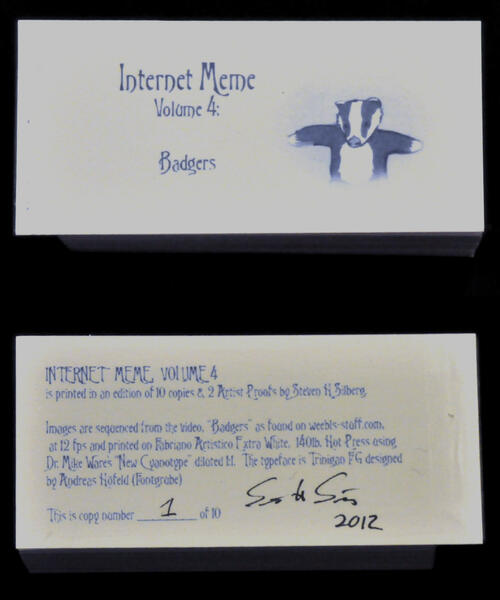 Internet Meme, Volume 4: BadgersColophon:
Internet Meme, Volume 4: BadgersColophon:
INTERNET MEME, VOLUME 4 is printed in an edition of 10 copies & 2 Artist Proofs by Steven H Silberg.
Images are sequenced from the video, "Badgers" as found on weebls-stuff.com, at 12 fps and printed on Fabriano Artistico Extra White, 140lb. Hot Press using Dr. Mike Ware's "New Cyanotype" diluted 1:1. The typeface is Trinigan FG designed by Andreas Höfeld (Fontgrube) -
Internet Meme, Volume I: Baby Cha ChaColophon:
INTERNET MEME, VOLUME 2 is printed in an edition of 10 copies & 2 Artist Proofs by Steven H Silberg.
Images are sequenced from the video, "Baby Cha Cha" as found on YouTube, at 12 fps and printed on Fabriano Artistico Extra White, 140lb. Hot Press using Dr. Mike Ware's "New Cyanotype" diluted 1:1. The typeface is Trinigan FG designed by Andreas Höfeld (Fontgrube) -
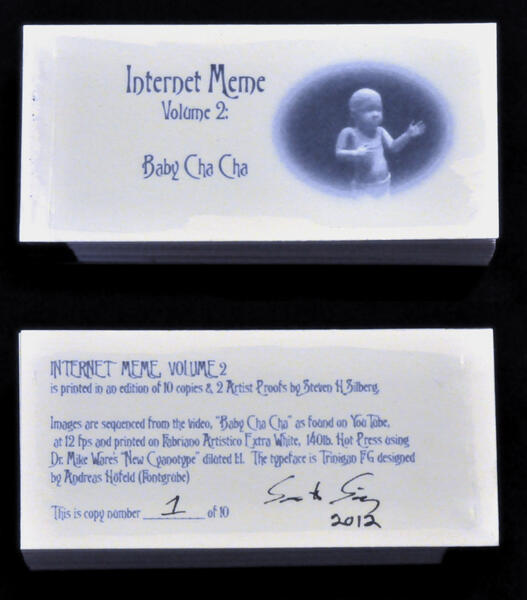 Internet Meme, Volume 2: Baby Cha ChaColophon:
Internet Meme, Volume 2: Baby Cha ChaColophon:
INTERNET MEME, VOLUME 2 is printed in an edition of 10 copies & 2 Artist Proofs by Steven H Silberg.
Images are sequenced from the video, "Baby Cha Cha" as found on YouTube, at 12 fps and printed on Fabriano Artistico Extra White, 140lb. Hot Press using Dr. Mike Ware's "New Cyanotype" diluted 1:1. The typeface is Trinigan FG designed by Andreas Höfeld (Fontgrube) -
Internet Meme, Volume I: Dramatic ChipmunkColophon:
INTERNET MEME, VOLUME 1 is printed in an edition of 3 copies by Steven H Silberg.
Images are sequenced from the video, "Dramatic Chipmunk", at 12 fps and printed on Fabriano Artistico Extra White, 140lb. Hot Press using Dr. Mike Ware's "New Cyanotype" diluted 1:1. The typeface is Trinigan FG designed by Andreas Höfeld (Fontgrube) -
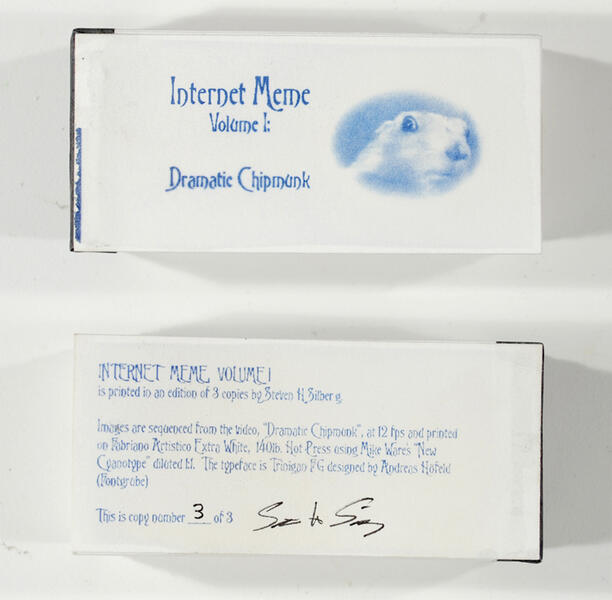 Internet Meme, Volume 1: Dramatic ChipmunkColophon:
Internet Meme, Volume 1: Dramatic ChipmunkColophon:
INTERNET MEME, VOLUME 1 is printed in an edition of 3 copies by Steven H Silberg.
Images are sequenced from the video, "Dramatic Chipmunk", at 12 fps and printed on Fabriano Artistico Extra White, 140lb. Hot Press using Dr. Mike Ware's "New Cyanotype" diluted 1:1. The typeface is Trinigan FG designed by Andreas Höfeld (Fontgrube)
Pipeline (2004), Now Playing (2007)
Selections from earlier works.
-
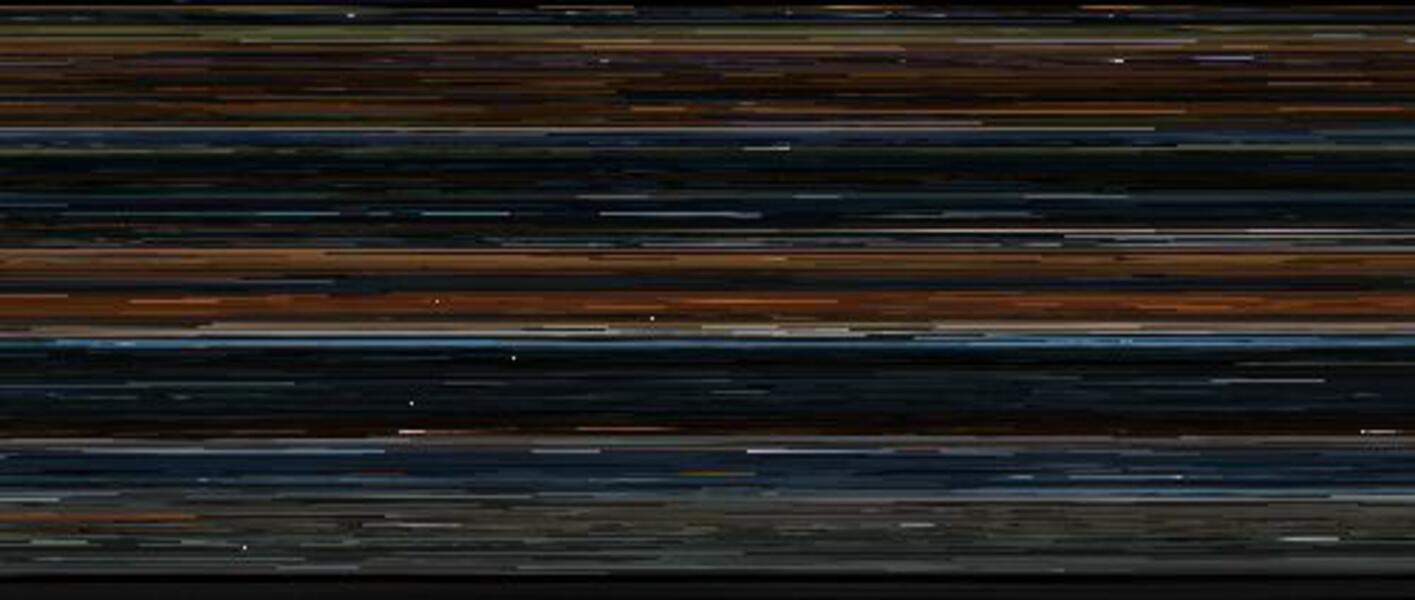 Now Playing: 'Lord of the Rings: Fellowship of the Ring'Lord of the Rings: Fellowship of the Ring (2001)
Now Playing: 'Lord of the Rings: Fellowship of the Ring'Lord of the Rings: Fellowship of the Ring (2001)
Peter Jackson
777 x 331 -
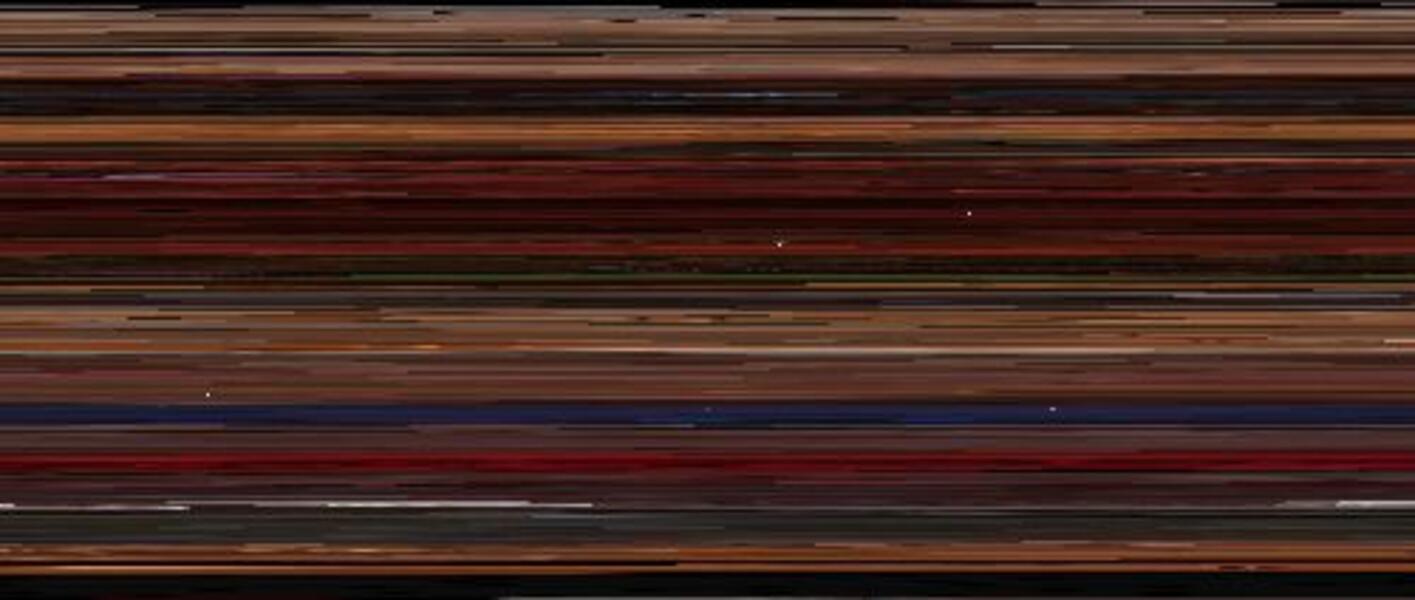 Now Playing: 'Fear and Loathing in Las Vegas'Fear and Loathing in Las Vegas (1998)
Now Playing: 'Fear and Loathing in Las Vegas'Fear and Loathing in Las Vegas (1998)
Terry Gilliam
634 X 270 -
 Now Playing: 'TRON'TRON (1982)
Now Playing: 'TRON'TRON (1982)
Steven Lisberger
571 x 243 -
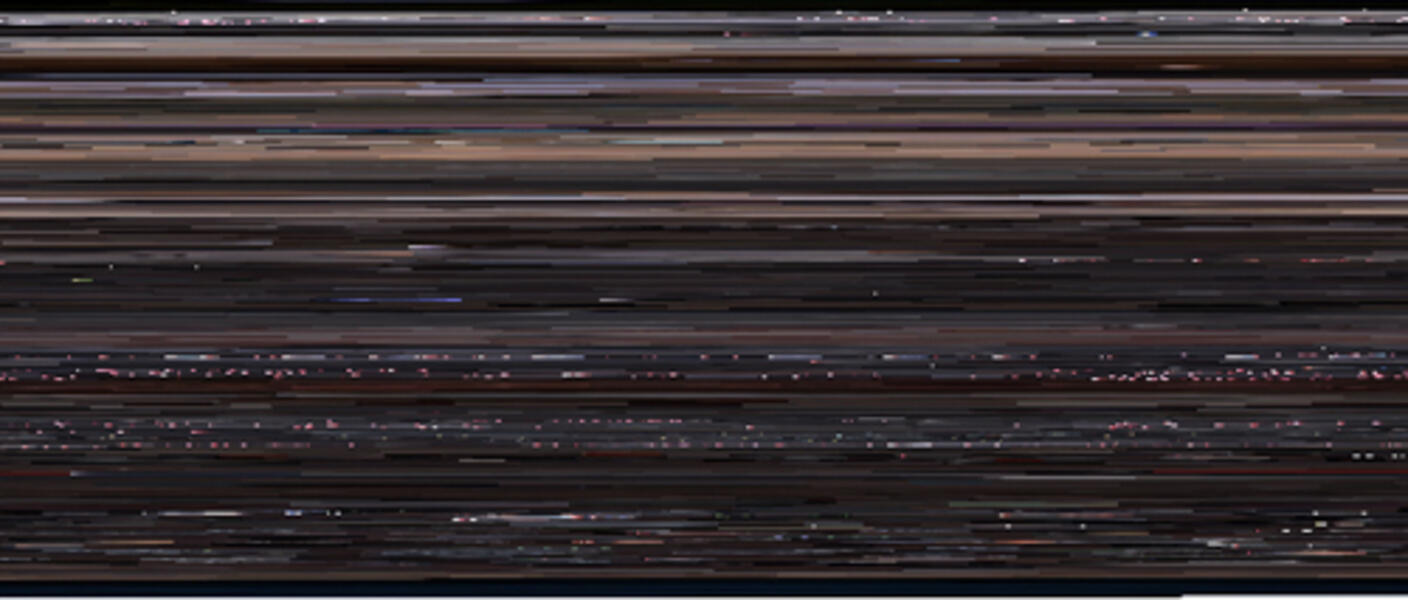 Now Playing: 'Star Wars: A New Hope'Star Wars: A New Hope (1977)
Now Playing: 'Star Wars: A New Hope'Star Wars: A New Hope (1977)
George Lucas
641 x 273 -
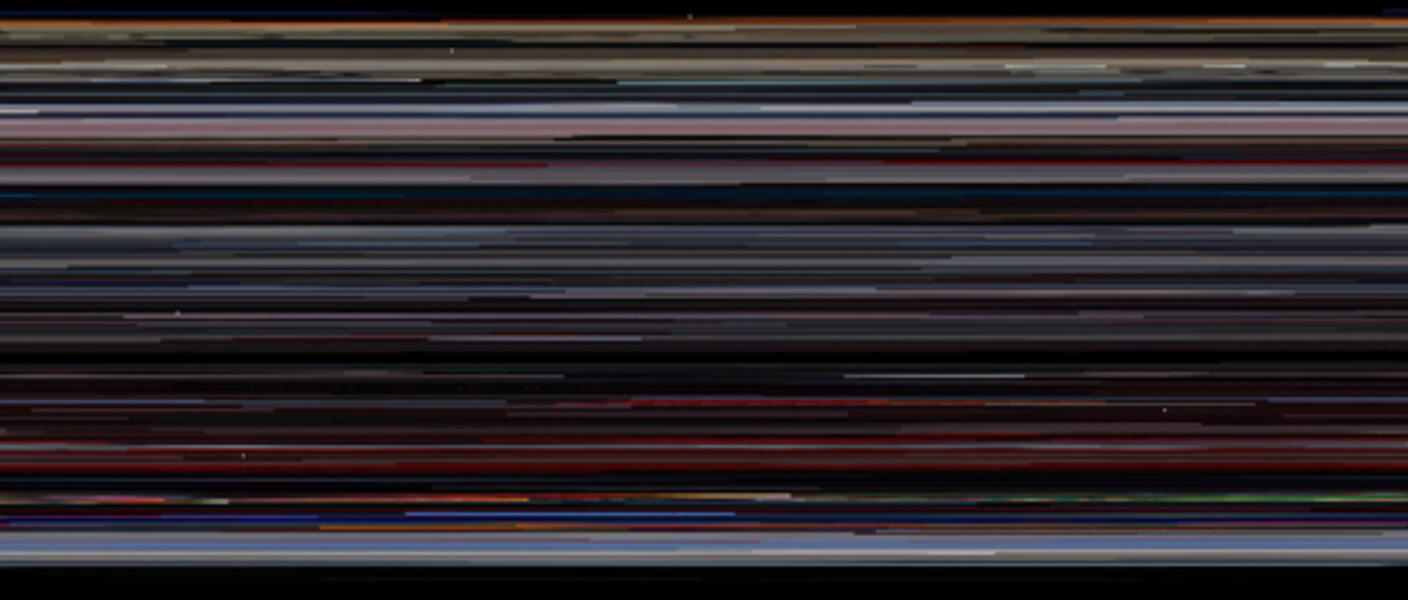 Now Playing: '2001: A Space Odyssey'2001: A Space Odyssey (1968)
Now Playing: '2001: A Space Odyssey'2001: A Space Odyssey (1968)
Stanley Kubrick
709 x 302
Long before the cave at Lascaux, humans attempted to record complex ideas and events through writing and drawing. Language developed as a means to abstractly represent actions and emotions, writing as a means to visually describe that spoken language. Words on the page have become shorthand for memories of experience.
Music uses the same model, transcribing symbols to a page to represent tempo, duration, and pitch. The notes on the staff of the conductor's score transcend sound alone aiding in the memory, feeling, and emotion of the musical experience.
In Western culture we find this transcription has been standardized in format, from left to right and top to bottom. Even our computer screens have been laid out in the same way, dividing image into discrete elements that individually are meaningless but as a whole describe a greater experience.
"Now Playing" records the feeling of a movie — the overall color cast of each individual frame — and sequences it left to right / top to bottom in the same manner as our music and writing. Borrowing from the formatting of a computer screen, each frame of a video or film is reduced to the size of one pixel and placed next to the moment in time that preceded it.
In each image the viewer is able to examine a representation of the entirety of a film while calling upon his/her memory of the experience of having seen the film. In essence, the image is a visual score of the temporal experience of the film that can be read or viewed in an instant.
A full archive of movies processed through this process can be found at: http://www.shsarts.com/wip/nowplaying.htm -
 Autumnal-detailCedar, Vine, Oil Paint 75" x 90" x 12" 2012
Autumnal-detailCedar, Vine, Oil Paint 75" x 90" x 12" 2012 -
 Pipeline: Receiver / InteractionUsers / Viewers interact with the receiver (microphone) to alter the original image [Beijing, 2006]
Pipeline: Receiver / InteractionUsers / Viewers interact with the receiver (microphone) to alter the original image [Beijing, 2006] -
 Pipeline: Recorded ImageImage recorded from the installation at the Decker Gallery, MICA, Baltimore, MD (Spring 2004)
Pipeline: Recorded ImageImage recorded from the installation at the Decker Gallery, MICA, Baltimore, MD (Spring 2004) -
video overview of "pipeline"(interactive installation)Project Statement
Within the artistic realm, there is the potential for manipulation, damage, decay, or loss to be exhibited as a creative process. This creation/damage itself occurs both because of, and in spite of, human interaction. The resulting artwork emerges from the collaboration between the disruptor of data and the reorganizer/interpreter of information.
By reassessing the relationship between the disruptor and the organizer, degradation can be considered a constructive process. The traditionally desired purity of data transmission and transfer, though experienced, becomes less preferable. Noise then becomes a tool of creative expression.
While the introduction of noise into an existing structure or system creates something new, it does so at the cost of the original. Degradation, as an act, may become a creative variation upon a source image, but that visual disruption reflects a loss of information.
-
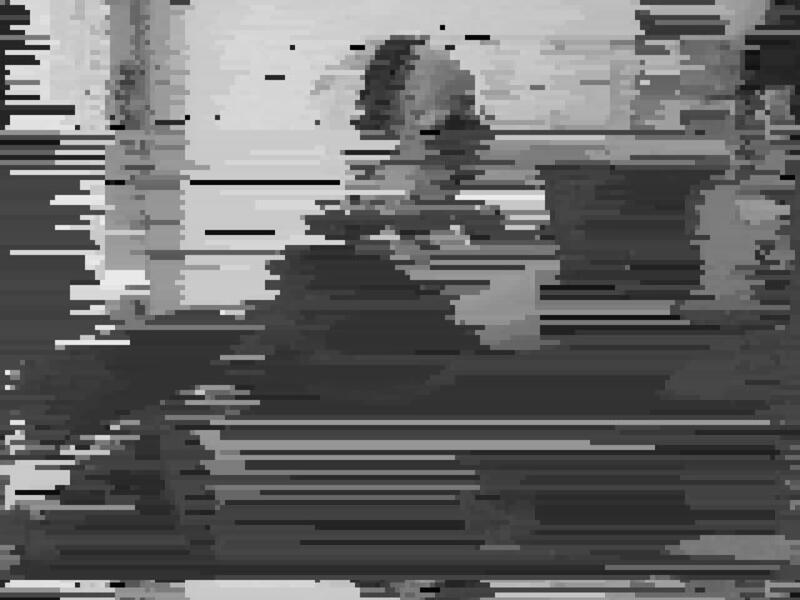 Pipeline: Recorded ImageImage recorded from the installation at Missouri State University (Fall 2007)
Pipeline: Recorded ImageImage recorded from the installation at Missouri State University (Fall 2007)

